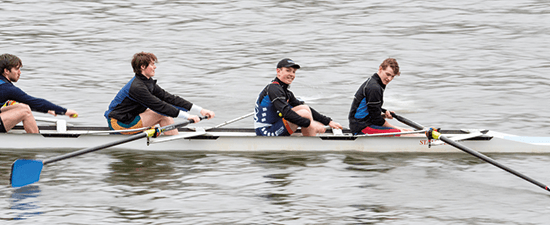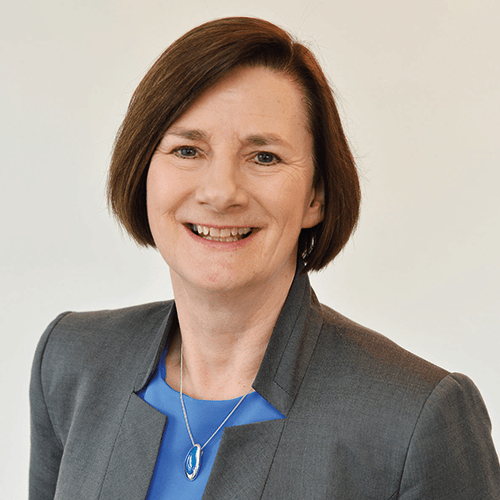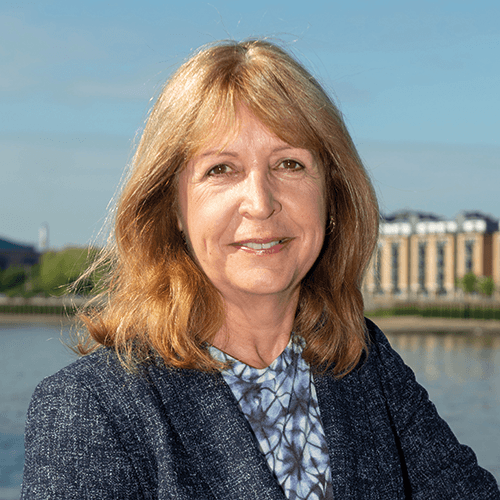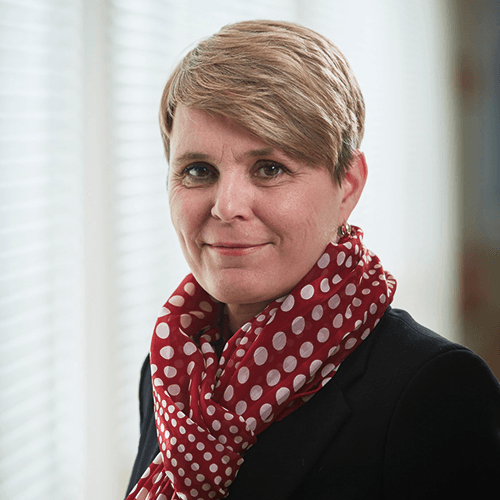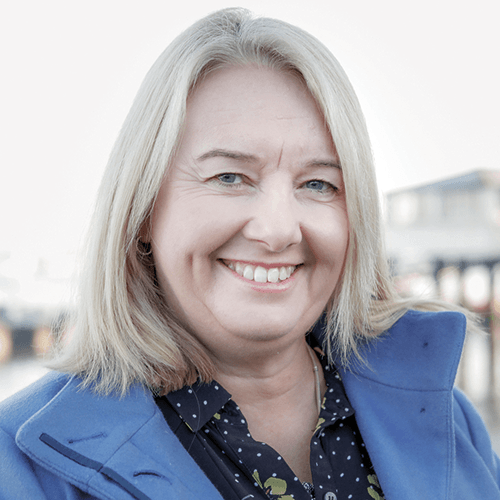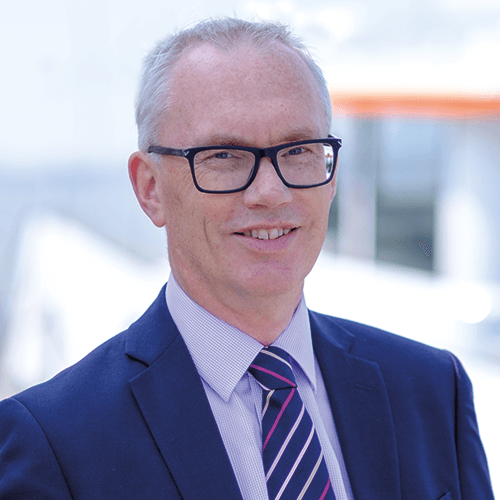Annual Report and Accounts 2020
Contents
Overview | Strategic Report | Performance | Governance | Financial Statements
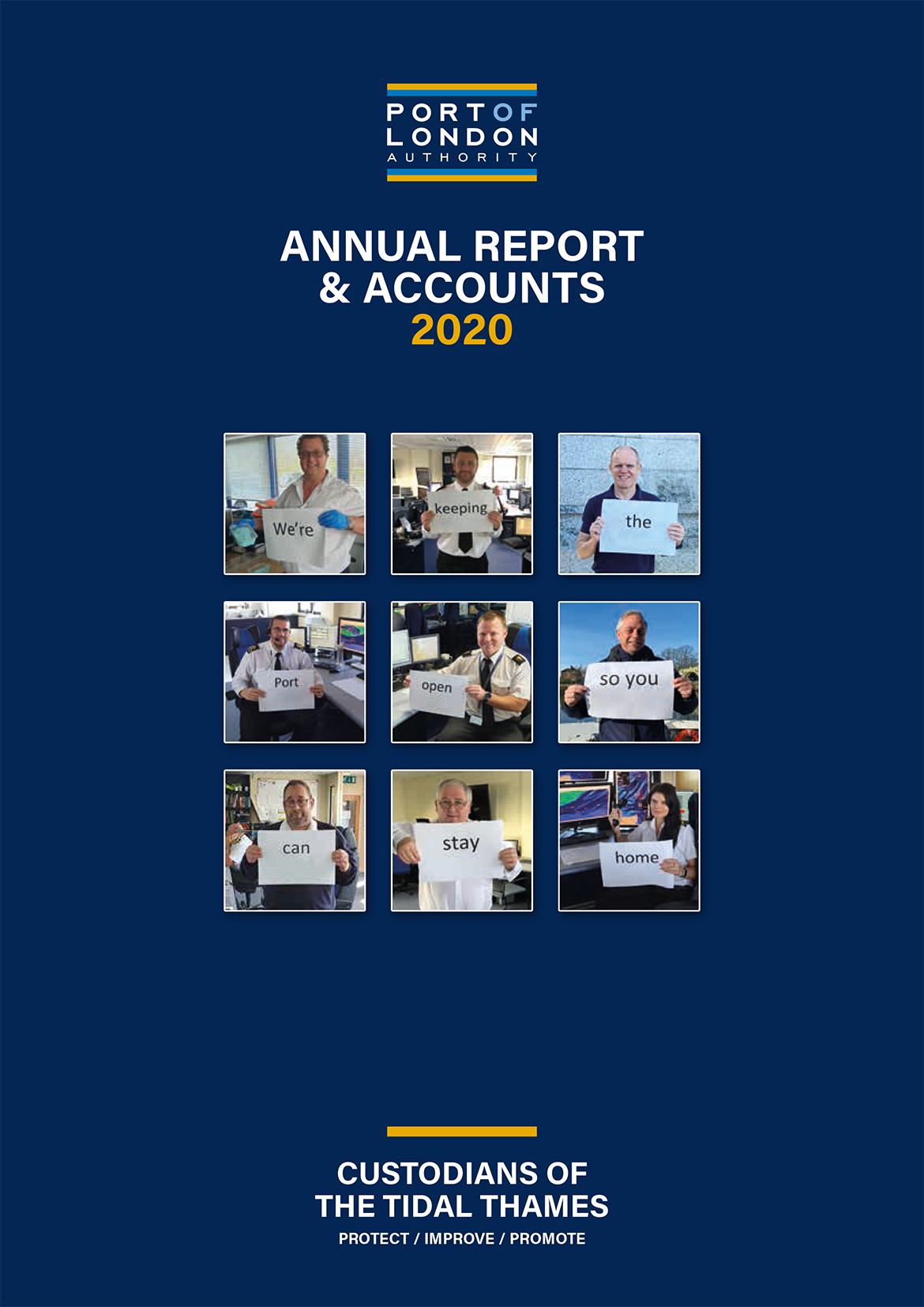 The Port of London Authority 2020 Annual Report is also available as a PDF.
|
OVERVIEW
ABOUT THE TIDAL THAMES
The tidal Thames is 95 miles of river from Teddington Lock, through central London, out to the North Sea. The river is home to the UK’s biggest port, the busiest inland waterway for freight and passengers and a growing centre for sporting activity.
The tidal Thames is also a thriving habitat, home to 125 different species of fish, 3,000 seals and more than 300,000 overwintering birds.
Economically, the port plays a key role as part of supply chains serving the UK markets of London, the south east and beyond. Over 48,000 jobs depend on the port, which generates more than £4.5 billion in economic value added annually. In addition, there are over 100,000 jobs related to the river as an amenity and economic activity generating a value added of over £2 billion.
ABOUT THE PLA
At the Port of London Authority we are the Custodians of the tidal Thames. We hold the river in trust, working to hand it on in a better condition to future generations and realising the goals of the Thames Vision.
Our strategy to achieve this is centred on key themes to:
PROTECT Targeting Zero Harm and improved sustainability
IMPROVE Running efficient operations and investing to support growing river use
PROMOTE Leading the Thames Vision to unlock the potential of the Thames
ABOUT THE THAMES VISION
The Thames Vision is a 20-year development framework for the river, created with stakeholders over 18 months from early 2015 to mid-2016. Across six goals, the Vision targets greater river use, alongside an improving environment.
The Vision is being delivered in partnership by the PLA and stakeholders; key elements of the Vision are reflected in the London Plan and the Mayor of London’s environment and transport strategies.
In 2021 we will be refreshing the Vision to reflect progress since its launch and to draw a greater focus on sustainability, diversity and recovery.
The six goals for the Thames Vision 2035 are:
- The busiest ever Port of London, handling 60 – 80 million tonnes of cargo a year.
- More goods and materials routinely moved between wharves on the river – every year over four million tonnes carried by water – taking over 400,000 lorry trips off the region’s roads.
- Double the number of people travelling by river – reaching 20 million commuter and tourist trips every year.
- The river the cleanest since the Industrial Revolution, with improved habitats and awareness of heritage.
- Greater participation in sport and recreation on and alongside the water.
- A riverside which is a magnet for ramblers, historians, artists and others, whether living nearby, on the river or travelling from further afield.
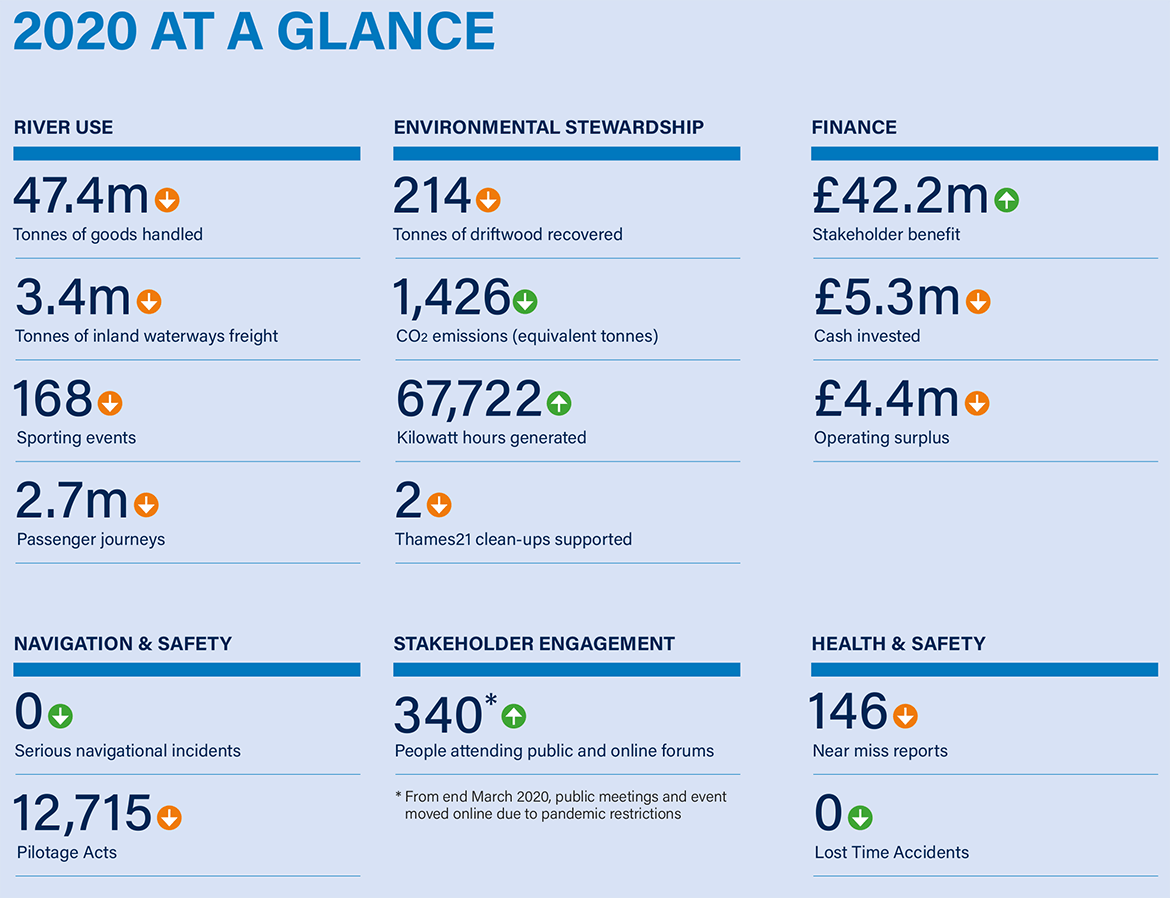
2020 HIGHLIGHTS
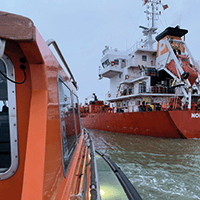
Operational resilience PLA provided uninterrupted services, sustaining essential supply chains delivering food, fuel and medicines. |
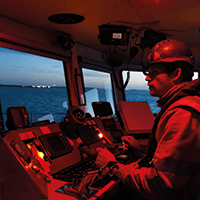
Safety A good year for safety, with zero significant marine incidents; and zero Lost Time Accidents. |
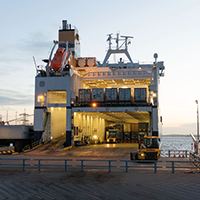
Tilbury2 New unaccompanied freight ferry terminal at Tilbury2 completed and started operations with tenant, P&O Ferries. |
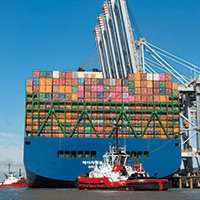
HMM Algeciras The world’s biggest container ship called at London Gateway port in June at the end of her maiden voyage from the Far East to Europe. |
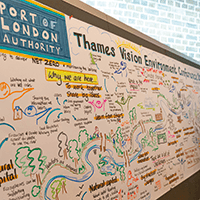
Sustainability Net Zero delivery programme developed and launched, committing to a Net Zero PLA by 2040, and its own emissions more than halved by 2025. |
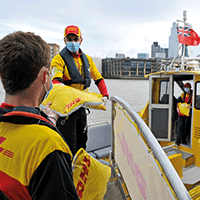
Freight Light freight first on the Thames, with DHL launching a river operation into its London parcel delivery service. |
STRATEGIC REPORT
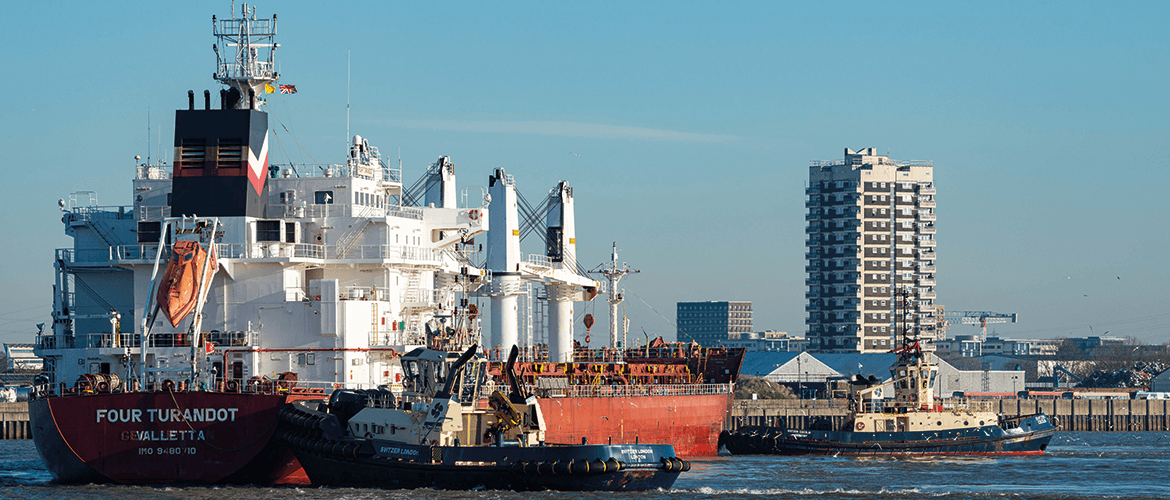
CHAIRMAN'S STATEMENT
Christopher Rodrigues CBE
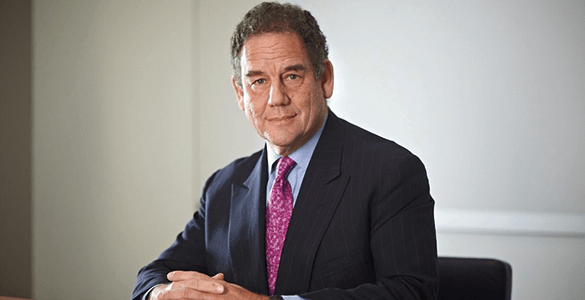 In 2020, COVID challenged the nation in ways last seen in wartime. Our frontline staff, on whom so many shippers depend, rose to the occasion and, thanks to the flexibility, commitment and hard work of all my colleagues, essential supply chains remained open and flowing.
In 2020, COVID challenged the nation in ways last seen in wartime. Our frontline staff, on whom so many shippers depend, rose to the occasion and, thanks to the flexibility, commitment and hard work of all my colleagues, essential supply chains remained open and flowing.
High service levels were maintained, and food, fuel and medicines arrived on supermarket shelves, petrol station forecourts and hospitals without delay.
The focus on resilience spanned the operational and the financial. We took the steps needed to keep people healthy and safe. We minimised spending - until we had greater clarity on the economic outlook.
We entered 2021 fit and ready to support economic recovery as lockdown restrictions are relaxed.
Alongside the delivery of those essential day-to-day services on which our customers rely, we also maintained momentum on long-term, strategic projects. These included charting and announcing our path to decarbonise our business – to reach Net Zero by 2040. The majority of our targeted improvements will be delivered within this decade.
The Port of London Act, which governs our operations, was last substantially revised almost 30 years ago. In 2020, we submitted a draft Harbour Revision Order (HRO) to the Marine Management Organisation (MMO) for review. The HRO seeks to modernise our processes and will be the subject of a formal MMO consultation process.
During the year we deepened our partnership with the Thames Estuary Growth Board, with whom we share the goal of increasing river usage and in 2021 we will refresh the Thames Vision, our development framework for the river.
As custodians of the Tidal Thames, we use the Vision to inform our priorities and to engage other stakeholders to take the actions needed to achieve the river’s full potential. With the businesses of some of our partners, particularly the passenger vessel operators, so badly affected by the pandemic and related restrictions, this work has never been more important.
To inspire our thinking, we commissioned research into how the other Great River Cities of the World were dealing with COVID and the effect it was having on their medium- and longer-term plans.
This became the topic for the first Great River Cities webinar, curated and hosted by the PLA and attracting over 200 delegates from more than 21 countries. As all such cities wrestle with common problems of post-virus recovery, we are looking to work more closely in the future, as collaborators, not competitors.
Every year I end this statement by thanking the PLA team, on behalf of the Board. I wholeheartedly do so again – for the courage shown by our frontline staff in getting out and continuing to deliver our services; and for the adaptability shown by all those who have continued to work hard behind
the scenes from home.
Thank you for all you have done in 2020 and thank you in advance for all you will do as we build back together. Also, my personal thanks to the strong support given by my fellow Board members.
A final note of thanks is due to the world’s seafarers on whose services we all depend for the passage of so many of our supplies. For many of them, 2020 was a year of enforced, lengthy absence from home. It is our pleasure to welcome and support them when they call at terminals on the Thames. They have our thanks for their selfless service.
Christopher Rodrigues CBE
Chairman
9 April 2021

CHIEF EXECUTIVE'S STATEMENT
Robin Mortimer
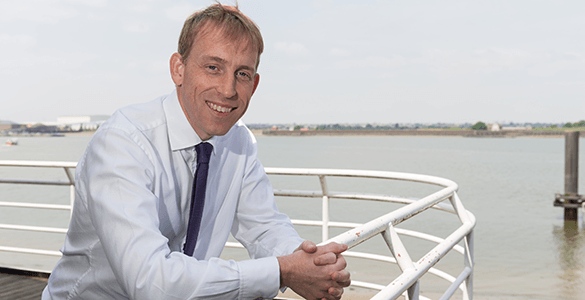 2020 was a year which showed the capability and strength of the PLA at its best. Responding to the coronavirus pandemic demanded that we continually flexed our approach, working patterns and much more in order to keep our teams safe and deliver our essential services. COVID-19 changed everything and all members of staff rose to the occasion.
2020 was a year which showed the capability and strength of the PLA at its best. Responding to the coronavirus pandemic demanded that we continually flexed our approach, working patterns and much more in order to keep our teams safe and deliver our essential services. COVID-19 changed everything and all members of staff rose to the occasion.
Throughout the year, we enabled operations in the Port of London to continue, with critical supply chains for food, fuel and medicines sustained uninterrupted. We continued providing our essential services without recourse to Government financial assistance packages, making available our full range of services through the year, with all our employees working throughout the pandemic response.
As we adjusted to the continuing flow of COVID-related requirements, we placed a premium on communications with our stakeholders, employees, river users and others, to keep people regularly updated about river developments.
This statement captures the impact of COVID-19 and associated restrictions on the port, wider river community and how we continued to shape and commit to future developments.
PORT & RIVER OPERATIONS
Port trade in 2020 was 47.4 million tonnes, a 12% fall from 54 million tonnes in 2019. The reduction in cargo throughput reflected reduced economic activity, following the introduction of COVID-19 restrictions. London was the UK’s biggest port nevertheless as essential supplies continued to flow and, later in the year, demand for unaccompanied freight ferry services increased, ahead of Brexit.
Resilience in the provision of our essential services to support port operations was our prime concern in 2020. Our pilotage service was uninterrupted, and we achieved a service level of 99.5%. We acted quickly to provide pilots with appropriate PPE, to ensure they were protected when boarding ships to navigate them into and out of the port. Pilots, cutter crews, VTS operators, taxi drivers and all others working to support essential port operations showed resilience and flexibility in continuing to operate effectively throughout the year, for which I express thanks on behalf of all river users.
The designation of a Thames Freeport, announced in March 2021 is great news for the port, PLA and the operators behind the bid, DP World London Gateway, Forth Ports and Ford Dagenham. It has potential to create new trade flows and technological innovation, drawing in new investment and helping level up the opportunities for some of the country’s most deprived communities.
Investment at Thameside terminals continued, with several major projects completed during the year. P&O Ferries started operations at phase one of Forth Ports’ Tilbury2 scheme from May onwards. The new terminal was operational within 18 months of the Development Consent Order (DCO) having been approved by the Secretary of State, which was an impressive achievement. DPWorld London Gateway welcomed the World’s largest container ship, HMM Algeciras, and attracted further new services, while planning for the construction and opening of Berth 4 continues apace.
Thames related developments by building material operators continued too. The new discharge facility at Northfleet for CEMEX, developed with investment from the PLA, was officially opened and its new marine aggregate dredger left the shipyard for sea trials. Hanson took on the latest phase of developments at its Dagenham depot and also has a new dredger, Hanson Thames, soon to come into operation.
The Tideway project continued to progress with the last tunnel boring machine, Selina, delivered to Chambers Wharf by river in a complex, PLA-coordinated operation. Selina will be used on the final 5.5 km main stretch of the super sewer to be tunnelled eastwards to Abbey Mills. The £4 billion project is expected to be fully operational by 2025, after a nine-month COVID-19 related delay was announced. Its legacy will be a cleaner river, seven new areas of public space along the Thames and wharf space released for long-term river use.
Inland waterways freight fell to 3.4 million tonnes, following the suspension of the majority of operations in the early days of the first lockdown; they resumed thereafter. Cory Riverside Energy operated throughout. The total volume of project related cargo transported on the river for Tideway topped four million tonnes in the Autumn.
COVID-19 had a major impact on the river’s passenger operations, with only 2.7 million passenger trips, compared to ten million in a normal year. However, plans for new piers continue to be advanced, the latest at Barking Riverside. During the year we released the findings of a study, jointly commissioned with TfL and carried out by ARUP, which sets out the scope and steps needed for growth in passenger travel on the river. The findings will inform the emerging plans for building back better, post-pandemic.
Hammersmith and Fulham Council’s closure of Hammersmith Bridge to river traffic from August onwards proved particularly challenging for all river users. Arrangements for a weekly transit system has brought some respite, but a long term solution is much needed. We are members of the Government-led taskforce set up by the Department for Transport (DfT) in September 2020, working towards the safe reopening of the bridge and will be assessing applications for a temporary ferry service to serve local communities while the bridge is closed.
FINANCIAL PERFORMANCE
We delivered a resilient financial performance in 2020. With the financial outlook very unclear at the end of quarter one, we focused on preserving cash and managed our spending very closely. Our operating surplus was £4.4 million (2019: £7.3 million) on a turnover of £63.9 million (2019: £67.4 million).
We contributed an additional £3 million, over the agreed recovery plan payment for the PLA pension scheme. The value of the funds in the pensions schemes in which we have an interest has been adversely affected by financial markets volatility prompted by the pandemic.
As a Trust Port we were well placed to provide focused support to customers affected by COVID-19, where it was needed. Through wide and continued engagement with our customers, we developed solutions tailored to individual circumstances. With passenger vessel operations suspended for the majority of the year, we repaid all Class V passenger vessel operators 2020 port dues and are waiving those same dues through to the middle of 2021.
SAFETY
2020 was a positive year for safety, both on the river in general and for our employees. No serious navigational incidents were reported, down from six in 2019.
There were also no Lost Time Accidents (LTAs) to PLA employees, visitors or contractors in 2020 (2019: two LTAs). Near miss reporting continued at a high level, with 146 near miss reports, compared to 172 in 2019.
One strong area of focus going forwards is pilot ladders. Analysis of near miss and incident reports in 2020 showed that problems with pilot ladder deficiencies had increased markedly. It is not acceptable for vessel operators to provide substandard or poorly rigged equipment on which our pilots rely for their safety, so we will be working on this with our customers, the Maritime & Coastguard Agency (MCA), and other relevant organisations.
INVESTMENT
We invested £5.3 million in the business in 2020. This was principally sustaining capital investment, maintaining our key assets such as radar equipment. We also made the final payments related to the refurbishment of our main Gravesend base, London River House, upgrading infrastructure and delivering a building with a significantly improved environmental performance and more modern facilities for staff and visitors.
Under the PLA Investment Plan, our focus in 2020 was on seeing projects, such as that with CEMEX at Northfleet, reach fruition; we also selected two tenants for Royal Primrose Wharf and developed site improvement plans essential for its reactivation. Looking to the future, we have identified and are pursuing several opportunities to secure riverside sites that will support future river use.
The investment we made in supporting habitat improvements at a number of RSPB reserves in North Kent and South Essex was completed and we look forward to seeing the results.
SUSTAINABILITY
Caring for the environment and improving our environmental performance is integrated into the way we do business at
the PLA.
After some 18 months of development, we ended the year with a detailed plan to achieve Net Zero PLA greenhouse gas emissions by 2040, agreed by the Board. Actions are already in hand that will deliver the first phase of the plan, more than halving emissions by 2025, in particular through switching our vessel fleet from diesel to sustainably sourced biofuel. As we push forward with this, we will continue to work with partners to support wider progress towards Net Zero within the Thames as a whole.
Our work around air quality continued. We published the results of our comprehensive and detailed air quality monitoring programme for the Greenwich Ship Tier and the first update of the Air Quality Strategy for the tidal Thames was released in June. Alongside this, we released the first roadmap for inland vessel emission reduction and launched the Thames Green Scheme to help operators demonstrate and be rewarded for environmental performance achievements. These and other developments were discussed at our Greening Inland Shipping webinar in the autumn. At the end of the year we submitted to Defra the third Adaptation Report on our preparedness for the predicted impacts of climate change.
LOOK AHEAD
We reached the end of 2020 as an organisation that had shown collective resolve and resilience through the first nine months of the pandemic and one which is fit for the future.
We are ready to support the imperative to build back better. We have an increasingly diverse workforce, a culture with health, safety and wellbeing at its heart, communal spaces in our main office better suited to collaborative working, a strong commitment to training, an Investment Plan delivering results and a path charted towards Net Zero.
These are strengths on which we will need to draw as we look ahead. We will need them as we support the recovery of a pandemic affected economy, river users coming back to the Thames after extended breaks, and others driving to Net Zero. The shaping of an updated Thames Vision will capture these ambitions over the longer term, looking out to 2050.
Like many other providers of key services, the PLA team was called on to respond in unique and trying circumstances through 2020. I am proud to have led an amazingly capable organisation who, together with our partners on the river, helped ensure that families across London and the south east continued to receive essential supplies through this very challenging time for all of us. My appreciation and thanks to everyone for all we have done together so far, and for the work we will continue to do in the coming year.
Robin Mortimer
Chief Executive
9 April 2021

CHIEF HARBOUR MASTER’S STATEMENT
Bob Baker
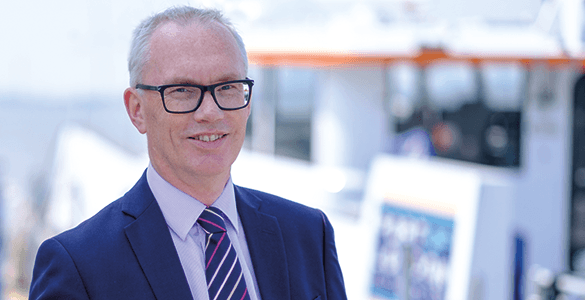 Last year saw markedly different activity levels on different parts of the river. While the commercial port continued to operate strongly, ensuring essential national supply chains were maintained, the river through central London and west of Putney was far quieter, in light of COVID-related lockdowns.
Last year saw markedly different activity levels on different parts of the river. While the commercial port continued to operate strongly, ensuring essential national supply chains were maintained, the river through central London and west of Putney was far quieter, in light of COVID-related lockdowns.
As we adapted our operations to be COVID secure, our prime concerns through this unique year were maintaining navigational safety and operational resilience.
There were no serious marine incidents on the tidal Thames in 2020, compared to six incidents in 2019. While welcome, this was clearly an exceptional year with river use reduced overall; the focus for the next Marine Safety Plan (2021-2023) is to reduce incidents by 10% over the next three years, compared to the previous three years. The resulting target for 2021 is no more than four serious incidents, ideally none.
We expect river safety performance in 2021 could be challenging, with many companies restarting their operations after several months shut down due to COVID restrictions.
To help reduce the number of safety incidents on the river we look at the root causes behind them. In 2020, pilot ladder deficiencies emerged as the leading factor, with 114 reports, up from 85 in 2019. The main points of concern were securing arrangements, together with the condition of the ladder itself and sub-standard rigging.
This increase is deeply concerning. ‘Fit-for-purpose’ ladders are vital to the safety of our pilots, and through them the safe conduct of the vessels they are boarding. It is a topic on which we shall continue vigorously to press.
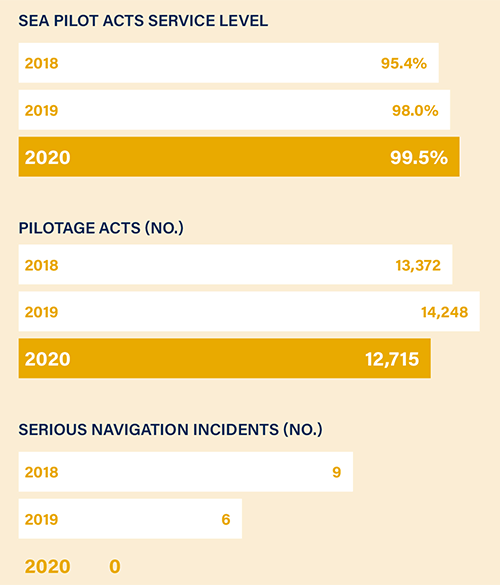 To underpin the developing safety culture on the Thames, we targeted increased Near Miss Reporting. A Near Miss Report promotional campaign in Summer 2020, when river operations were largely unfettered, boosted reports, but we ended the year down on target due to the reduced level of activity in some parts of the river.
To underpin the developing safety culture on the Thames, we targeted increased Near Miss Reporting. A Near Miss Report promotional campaign in Summer 2020, when river operations were largely unfettered, boosted reports, but we ended the year down on target due to the reduced level of activity in some parts of the river.
Pilotage acts fell from the 2019 record of 14,238 to 12,715 in 2020, as a number of trades, particularly tankers, called less frequently on the Thames. Our pilotage service level was 99.5% of all ship calls served as booked.
We continued to recruit pilots to match our pilotage team to demand. Short-term our ability to progress their training has been limited by lockdown restrictions. This is a position we are looking to recover just as soon as things open up again. We also invested in equipment for pilots, buying two more portable pilot units, which are key to handling the larger vessels now arriving more frequently at London Gateway.
Towards the end of the year, we restructured the Harbour Masters team, adopting a ‘whole river’ approach, from the previous structure based on river districts. The new arrangement will enable us to provide a more consistent and resilient service to river users and stakeholders.
More detailed information on our safety work can be found in the River Navigation section of this Annual Report.
Bob Baker
Chief Harbour Master
9 April 2021

CHIEF FINANCIAL OFFICER'S STATEMENT
Julie Tankard
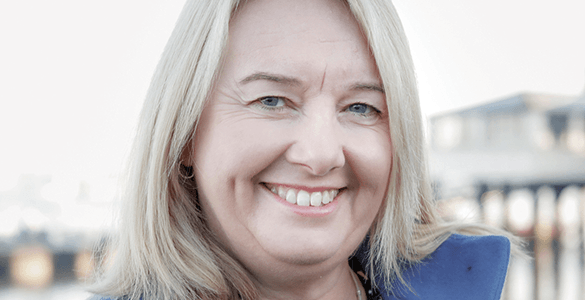 The port remained operational throughout 2020, with our services delivered uninterrupted, sustaining essential supply chains. The fall in economic activity and reduction in some cargo volumes prompted by the pandemic impacted us financially, with overall turnover down by 5% compared to 2019, at £63.8 million.
The port remained operational throughout 2020, with our services delivered uninterrupted, sustaining essential supply chains. The fall in economic activity and reduction in some cargo volumes prompted by the pandemic impacted us financially, with overall turnover down by 5% compared to 2019, at £63.8 million.
Delivering resilient operations was our main priority. Fundamental to this was looking after the health, safety and wellbeing of our colleagues, providing the personal protective equipment (PPE) they needed as part of a COVID-secure operation. We did not furlough any PLA employees or access any UK Government COVID-related loan facilities.
All non-core spend was reduced as soon as the potential impact of the pandemic on the economy and our finances became clear. These early steps enabled us to deliver an operating profit of £4.4 million (2019: £7.3 million), a year-on-year fall of 40%. Overall profit after tax was £2.6 million (2019: £10.3 million).
Our marine related income for conservancy, pilotage and other marine services fell to £48.6 million (2019: £52.2 million), all depressed by the slowdown in the economy. Income from river works license, rents and investment properties rose by 9%, as our investment strategy started to generate increased income.
We took the decision during 2020 to reclassify some of the sites we own as investment properties, as they are held principally to generate future income for the PLA. This resulted in an improvement in the balance sheet of £46.3 million. There was an overall loss of £1.7 million on existing investment properties, after a comprehensive external revaluation exercise.
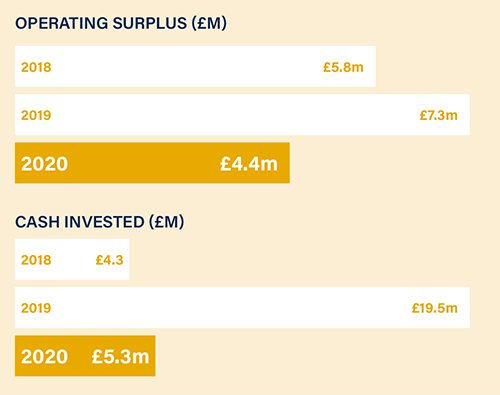 We continue to hold sufficient cash and reserves to service our long-term goals and reflective of our long-term liabilities. This stood us in good stead during the pandemic as we saw significant fluctuations in income in the first lockdown. Volumes of oil cargoes moved through the Thames were markedly depressed, with shipments of aviation fuel essentially ceasing, due to the dramatic reduction in air travel. Until there is a return to international travel, this income stream will continue to be reduced.
We continue to hold sufficient cash and reserves to service our long-term goals and reflective of our long-term liabilities. This stood us in good stead during the pandemic as we saw significant fluctuations in income in the first lockdown. Volumes of oil cargoes moved through the Thames were markedly depressed, with shipments of aviation fuel essentially ceasing, due to the dramatic reduction in air travel. Until there is a return to international travel, this income stream will continue to be reduced.
Despite a reduction in the demand for pilotage as volumes fell, we continued to recruit pilots. This is part of the investment we have been making in our pilotage operations for more than five years, to deliver the high level of service our customers expect. The financial impact of this continued investment was a £1.9 million operating deficit on pilotage operations in 2020, compared to breakeven in 2019.
Pilotage is strategically important and fundamental to our business. Our 2021 charges reflect an increased fee for providing pilotage on containerships over 345 metres in length, where two pilots are required. As a post balance sheet event, we acquired Peel Ports’ 50% share in Estuary Services Limited, the pilot boarding and landing service joint venture we had with them. This strategic investment will give greater control over an important part of our operation.
Over the last three years we have focused closely on diversifying our income, by investing in property and assets that will support greater use of the river, a key aim of the Thames Vision. Our rental income grew to £12.7 million in 2020 (2019: £11.7 million). This increase resulted from market-related river works licence income rises, rent from investment land where safeguarded wharves are brought back into use and income from the CEMEX Northfleet project, completed in 2019.
No new assets were acquired as part of our Investment Plan in 2020. We have identified and reached advanced stages on several new opportunities, which will come to fruition in 2021.
We invested £5.3 million in improving our operational assets during the year. A large part of this was upgrading London River House, the main building from which we operate in Gravesend, which required extensive updates to mechanical and electrical services. The completed project delivers lower energy consumption and new renewable energy generation, in line with our goal for the PLA to be Net Zero by 2040, or earlier. We also upgraded some of our IT systems and equipment, which was vital to flexible and agile working during the pandemic.
The main PLA pension scheme continues to be a significant liability. We developed and consulted on a new defined contribution pension scheme in 2020. From 1 January 2021, all new employees enter this scheme, rather than the defined benefit scheme. This removes our exposure to future asset volatility in the defined benefit scheme, a long-term benefit to the PLA.
We continue to address the liability in the main PLA pension scheme. In late 2020 we put an additional £3 million into this scheme, on top of the £4 million paid into the fund under the deficit repair plan agreed with the Trustee. The total £7 million contribution to the main pension fund represented 11% of our 2020 income. Despite the agreed and additional payments, the net liabilities on the pension schemes in which we participate increased by £4.2 million (£66.1 million in 2020, compared to £61.9 million in 2019).
After a challenging year, the overall outlook for the PLA is positive. We are well placed for increased river activity and demand for our services. Our healthy cash balance will underpin the Investment Plan, as we continue to look to diversify our income. The pandemic showed the importance of this part of our strategy, supporting long-term sustainable growth.
Julie Tankard
Chief Financial Officer
9 April 2021

OPPORTUNITIES AND CHALLENGES
At the PLA we manage and respond to a range of opportunities and challenges. This section sets out our headline view of key opportunities and challenges. The Governance section of this report provides details of the full array of factors we address through our risk management process.
OPPORTUNITIES
Despite the downturn in trade, the mix of cargo helped to lessen the impact of the decline in oil products volumes in 2020. Long-term port trade growth remains a major opportunity for the PLA, with significant investment continuing by operators including DP World at London Gateway and Forth Ports at Tilbury.
Securing designation of a Thames Freeport represents a major opportunity for the PLA and the operators leading it, DP World London Gateway, Forth Ports and Ford Dagenham. It will provide a substantial boost to economic development, innovation and port trade.
The economic certainty following the conclusion of negotiations around the trading terms between the UK and the European Union presents opportunity for increasing trade on the Thames. The ‘unaccompanied freight’ model used by freight ferry operators on the river is well suited to the new customs requirements.
Supporting carefully selected and assessed riverside property acquisition and development schemes under our Investment Plan supports growing river use. Completed projects demonstrate solid returns and are increasing tonnages on the river, as well as diversifying our income streams, improving financial resilience. There is a strong pipeline of further investment opportunities identified for the short- and medium-term.
The Thames Tideway Tunnel project has provided both opportunity and challenge. The principal long-term benefit of the scheme is a cleaner river. In terms of construction operations, the project’s use of the river has underpinned investment in vessels, tugs and barges and embedded higher standards on the river, a legacy for the future.
Notwithstanding the pandemic-related dip in river freight and passenger services in London, the expected long-term growth in activity means that more skilled people will be needed to work on the river. On a busier river, the skills of existing workers will need to be maintained and improved. This is being addressed through our work with the Thames Skills Academy, the Company of Watermen & Lightermen and Thames operators themselves.
New trade and business opportunities are emerging in a decarbonising economy. As a business we have a commitment and route to achieve Net Zero by 2040. We are working with companies on the Thames and beyond to embrace the opportunities for decarbonisation that new technology affords, for example through the Roadmap for Inland Vessels Emissions Reduction. In addition, the launch of a Sustainable Innovation Fund will act to support ‘greenhousing’ new, Thames-relevant technologies to the benefit of the PLA, river users and riverside communities.
The scope of opportunity set out here will be captured in the refreshed Thames Vision. This development framework for the river, which targets increasing all aspects of river use, will be shaped through 2021. The time horizon will be taken out to 2050, from 2035 in the original Vision. The review of the Vision will reflect the evolution of stakeholder expectations, technical, environment and economic developments in the society we serve.
CHALLENGES
In dealing with the coronavirus pandemic we have faced both operational and economic challenges. Operationally we took steps to create a COVID secure workplace to protect our key operational staff from exposure to the virus in order that port control, pilotage services and essential marine maintenance services could continue to play their role in supply chains. In line with Government requirements, we facilitated home working for those of our staff who could work from home.
Ensuring cyber security remains a challenge, with attacks on IT systems increasing during lockdown. We operate rigorous systems for checking emails and links. During 2020 we adopted enhanced user authentication to further address this issue.
The national lockdowns and other restrictions introduced in order to manage the spread of the virus had a marked impact on economic activity. This saw port trade in 2020 fall by 12% overall. At the same time, responding to the virus accelerated trends in retail and logistics that make prospects for recovery difficult to anticipate.
Alongside the economic impact of the coronavirus, other developments with potential to impact on the economy, and PLA specifically, include the possible economic impact on trading patterns of leaving the European Union and the switch away from fossil fuels for transport. The latter trend is already manifest and is expected to accelerate, following the Government’s 2030 ban on the sale of new internal combustion engine powered cars.
Increased volatility in financial markets prompted by COVID-19 has impacted the value of the pension schemes in which the PLA has an interest. It has increased deficits in the pension schemes, to which we will have to respond, potentially impacting on our financial flexibility.
Demand for our pilotage services has remained strong through the pandemic as the river sustains essential national supply chains. As the hoped-for recovery establishes, we will need to continue meeting the ‘on demand’ requirements of our customers. We are investing in both new pilot recruitment and equipment to meet this demand. The national restrictions introduced through 2020 to ensure greater COVID security impacted on our ability to advance new pilots’ training quickly. It is a position we will work to recover as restrictions start to be lifted.
The Tideway scheme presented a navigational safety challenge linked to the operation of 12 construction sites in and alongside the river. Having a dedicated Tideway harbour master and Tideway focused group within our licensing team enabled us to manage the high level of consenting and other demands linked to the project.
Useable river space is finite. We work to balance the competing demands for this space, for trade, travel and recreation. Developments with potential to encroach on usable river space include new crossings and new or expanded windfarms.
There is a clear need for more river crossings in London and their development is something we support as essential to continued economic development. We engage around specific proposals to ensure they are compatible with an increasingly busy maritime city river, with established rights of navigation unimpeded.
The closure of Hammersmith Bridge by the local council to all bar once-a-week transits of river vessels highlights another river crossing challenge. This is effectively closing a marine highway through London, which will impact boatyards and other essential infrastructure in the winter, passenger trades in the summer in particular and recreational users daily. We are working with the Government taskforce on short-term ferry solutions to help reduce the impact on local communities now facing lengthy diversions to cross the river. The weekly river transits are coordinated by us and we are making the case for reduced restrictions on river transits.
UK windfarm capacity continues to expand, in line with the drive for renewable energy to play a greater part in the nation’s energy mix. The Thames estuary is already home to a number of large windfarm developments, existing alongside the channels serving the UK’s biggest port. Any further proposals are subject to careful consideration to ensure that they do not prejudice safe navigation, something on which we engage actively with scheme developers, shipping lines, service providers and terminal operators who would be affected.
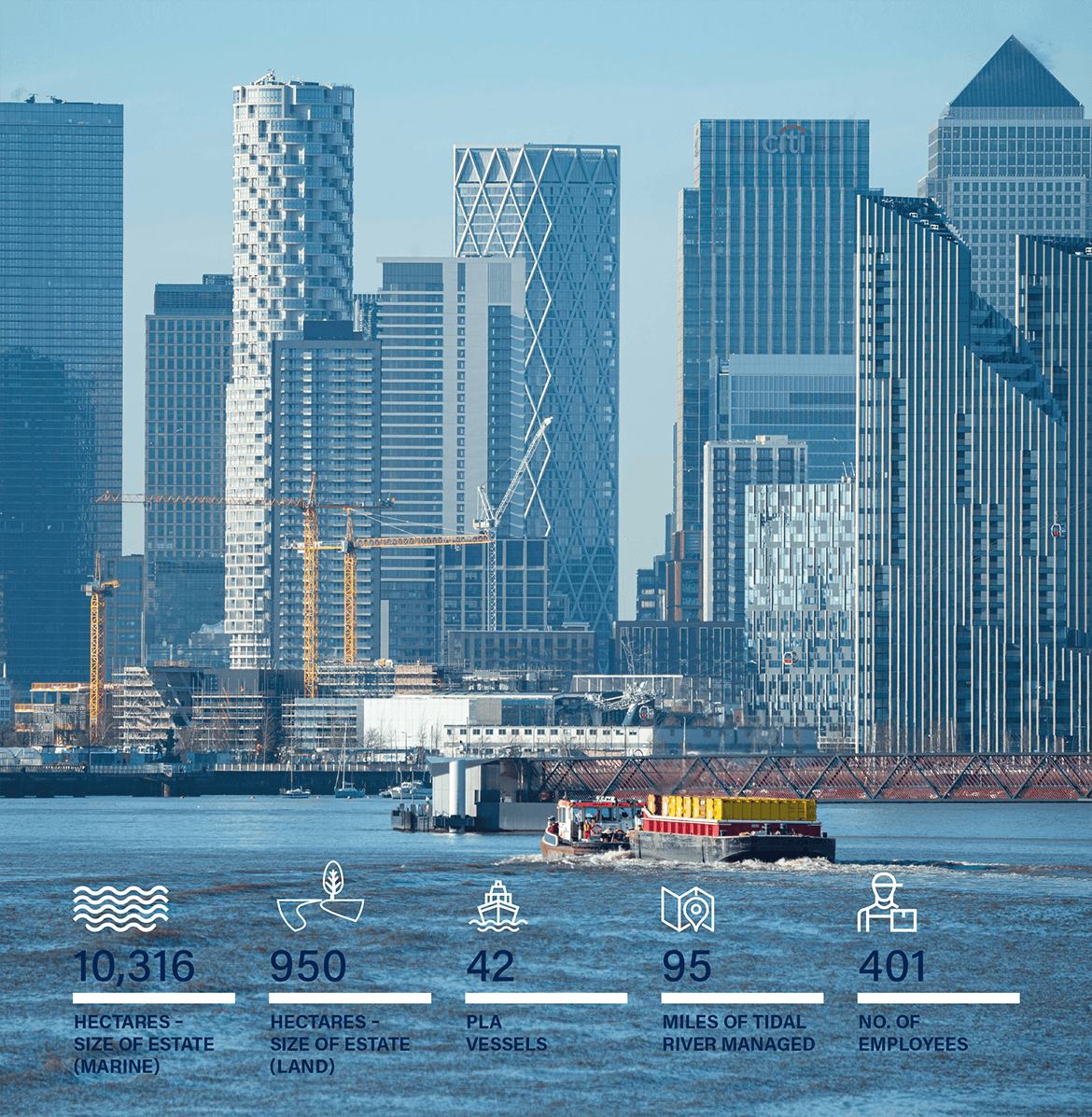
PLA STRATEGY
As a Trust Port, we hold the Thames in trust for future generations. We have no shareholders, so operate for the benefit of customers and stakeholders now and in the future.
The stakeholders’ ambition, as set out in the Thames Vision, is to see the river play a much greater role in the life of London and the south east, from trade and travel to sport and recreation. To support this ambition, our strategy is centred on three core roles for the PLA:
Protect targeting Zero Harm and improved sustainability
Improve running efficient operations and investing to support growing river use
Promote leading the Thames Vision to unlock the potential of the Thames
The Thames is the UK’s busiest inland waterway and the Port of London the country’s biggest port. The most recent assessment of the economic impact of the port, completed pre-pandemic in early 2020 found a total of 48,000 jobs sustained by the port and river, which made a Gross Value Added contribution to the economy of £4.5 billion. Returning to these levels will be a target in the refreshed Thames Vision, as we build back better after the pandemic.
Our experience shows that a strong and effective PLA supports growth through creating the ‘virtuous circle’, shown below. Delivering on our commitments to Protect, Improve and Promote will help develop the competitiveness and sustainability of port and river operations. This underpins growth in river use and generates a financial return, which we can invest again in protecting, improving and promoting.
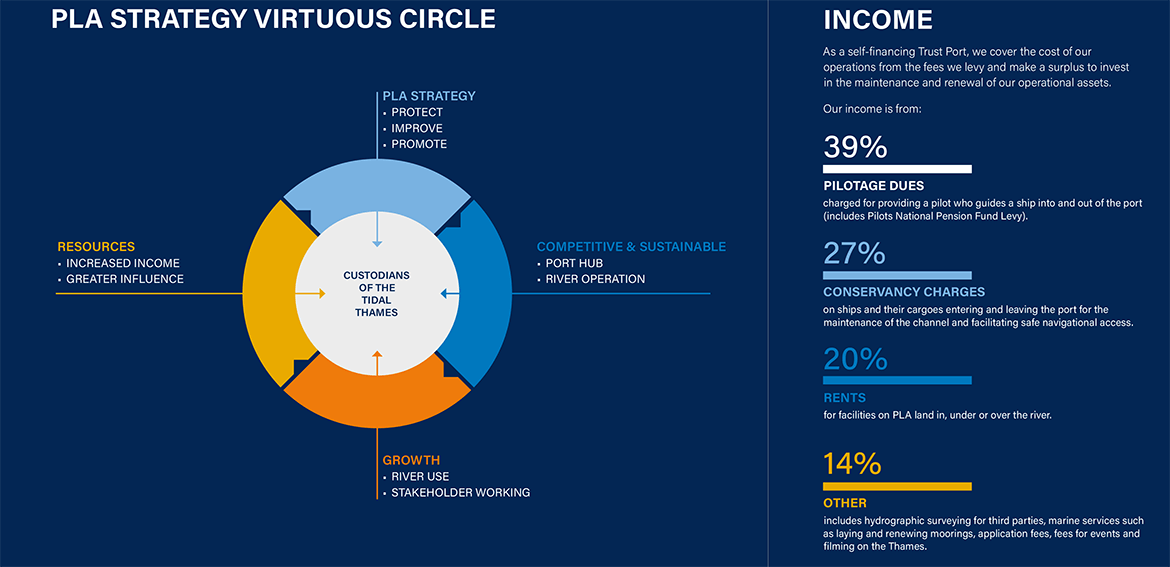
STAKEHOLDER BENEFITS
As a Trust Port we provide stakeholders with a range of benefits, alongside discharging our specific duties. When asked in independent research, stakeholders identified our main contributions being in: river navigation and safety; environmental stewardship; planning consultation and technical expertise; bringing people together and promoting the river.
Over the last five years we have increased our river advocacy through the development with stakeholders of the Thames Vision. The Vision, launched in mid-2016, provides a framework for the river’s development over 20 years to 2035. We will be working with stakeholders through 2021 to review and update the Vision for an extended time period out to 2050, in line with the Government’s Net Zero commitment.
Our main contributions to stakeholders are, in more detail:
RIVER NAVIGATION AND SAFETY
Our port control centres, harbour masters, hydrographers, river patrol and pilot cutter crews help keep river users safe. Our salvage operations and divers keep the river clear of obstructions and open for business. We are responsible for river traffic control and navigational safety, including buoys, beacons, bridge lights and channel surveys.
ENVIRONMENTAL STEWARDSHIP
We hold the tidal Thames in trust, with the remit to hand it on to succeeding generations in better condition. A major part of our work is conservancy of the Thames, maintaining the main navigation channels on the river. As stewards of the marine environment, we look after the river’s many assets, conserving wildlife, keeping the river clean and free of rubbish with our Driftwood service. We are working closely on improving air quality on the tidal Thames. We maintain the tow path, revetment wall and have an active tree management programme along a stretch of the Thames up-river of Putney. Promoting the use of the river as a natural, low-carbon transport route is a key activity too.
PLANNING CONSULTATION AND TECHNICAL EXPERTISE
We provide information, support and significant technical expertise to help river users and investors maximise the value of the river, and to do it safely. We consent river works and dredging on the river, applying our expertise to keep river users safe and protect the environment.
BRINGING PEOPLE TOGETHER AND PROMOTING THE RIVER
We bring people together to discuss how to make the best use of the Thames and advocate its potential. We work with, and for, a wide range of stakeholders and partners on commercial freight, investment, property, safety, conservation, leisure, tourism, passenger transport, sporting pursuits and major events. We try hard to be a ‘listening’ organisation as well as one that delivers what our stakeholders need and want.
STAKEHOLDER BENEFIT
Set alongside the economic and amenity benefits that our operations underpin, we also generate a substantial benefit to the community, estimated to be £42.2 million in 2020 (2019: £41.0 million). Our major direct community contributions are to organisations including Tilbury Seafarers Centre and Thames Festival Trust. We also undertake activities required for our core responsibilities, such as making our archive publicly available at the Museum of London Docklands. Our support for Thames21 links to the core objective of improving the marine environment.
No major investments were made under the PLA Investment Plan through the year, in line with prudent cash conservation during the pandemic; £19 million was invested in 2019, when a wharf was acquired. The Investment Plan principally supports developments focussed on increasing use of the river, in line with Thames Vision goals.
Existing investments under the Plan were progressed during the year, seeking partners for the reactivation of Royal Primrose Wharf, securing necessary improvement works repairs to the river wall at Plaistow Wharf and CEMEX Northfleet officially opening.
More than £38.3 million is paid in taxes, wages and other employment costs which contribute directly to the local economy. A full breakdown of our stakeholder benefit calculation can be seen in the table at right.
|
PLA In the Community |
2020 (£) |
2019 (£) |
|
Major charitable donations |
||
|
Thames21 |
£30,000 |
£35,000 |
|
Thames Explorers Trust |
£0 |
£35,000 |
|
Thames Festival Trust |
£45,000 |
£60,300 |
|
Tilbury Seafarers Centre |
£33,460 |
£31,500 |
|
Other charitable donations |
£3,742 |
£37,115 |
|
Riverside Code & Community Outreach |
£600 |
£8,663 |
|
Museum of London Docklands – membership |
£31,234 |
£28,610 |
|
Community Activities on the River |
£11,200 |
£31,000 |
|
Museum of London Docklands – 2021 exhibition |
£60,000 |
£160,000 |
|
Thames 21 (administration costs) |
£72,000 |
£70,000 |
|
Gravesham Borough Council (Town Pier) |
£3,833 |
£3,743 |
|
£291,069 |
£500,931 |
|
|
Investment Plan |
||
|
RSPB habitat improvement works |
£85,477 |
£58,855 |
|
£85,477 |
£58,855 |
|
|
Activities required for core PLA responsibilities which generate wider stakeholder benefit |
||
|
Archive at Museum of London Docklands |
£103,097 |
£82,688 |
|
River bank maintenance |
£64,375 |
£46,622 |
|
Richmond Lock and Weir |
£576,189 |
£1,090,128 |
|
£743,661 |
£1,219,438 |
|
|
Government Benefit* |
||
|
Taxation – Pay As You Earn |
£9,630,340 |
£9,528,703 |
|
National Insurance (employer's and employees elements) |
£5,159,536 |
£5,040,922 |
|
Corporate taxation and business rates |
£227,054 |
454,589 |
|
£15,016,930 |
£15,024,214 |
|
|
Business Community Benefit |
||
|
Subscriptions to business organisations |
£79,115 |
£104,888 |
|
Thames Estuary Partnership |
£15,000 |
£18,750 |
|
Thames Skills Academy |
£25,000 |
£25,000 |
|
£119,115 |
£148,638 |
|
|
Employees’ Benefit |
||
|
Employee remuneration, pensions costs and benefits |
£25,964,790 |
£24,069,905 |
|
£25,964,790 |
£24,069,905 |
|
|
Total Stakeholder Benefit |
£42,221,042 |
£41,021,982 |
* Includes Port of London Properties (POLP) and 50% of Estuary Services Limited (ESL) and based on business rates plus the current tax charge, before prior year restatements.

ENGAGING WITH STAKEHOLDERS
As a Trust Port we work closely with our stakeholders in maintaining a safe river, caring for the environment and promoting use of the Thames. This section details how we engage with stakeholders, drawing their views into our decision-making processes.
Department for Transport guidance describes a Trust Port as:
‘a valuable asset presently safeguarded by the existing Board, whose duty it is to hand it on in the same or better condition to succeeding generations. This remains the ultimate responsibility of the Board, and future generations remain the ultimate stakeholder.’
In considering the long-term development of the river, the Board has regard to factors including: long-term consequences; how decisions affect our customers, employees and the wider community; minimising environmental impacts and improving the environment wherever possible; reputational implications; and fairly balancing different stakeholder needs.
In running the PLA, the broad stakeholder groups the Board considers are:
- Customers: river users (including operators of seagoing cargo vessels, inland barges, passenger vessels and recreational users), commercial port operators (including the operators of cargo handling facilities) and others (including our licensees, tenants and those to whom we provide third party services)
- Employees
- Local communities and NGOs
- Government, elected representatives, regulators and local authorities
Board members remain in touch with key stakeholders’ views through engagement, studies and visits including:
- Annual employee engagement study
- Annual stakeholder audit
- Annual stakeholder meeting
- Public meetings
- Site visits
- Customer meetings and feedback
The following charts set out the main types of stakeholders, their areas of interest, our engagement channels and how different Board Committees and the Board of Directors address stakeholder interests.
|
Customers |
||||
|
Areas of interest |
Engagement channels |
Committee/Board Agenda |
||
|
|
|
||
|
Employees |
||||
|
Areas of interest |
Engagement channels |
Committee/Board Agenda |
||
|
|
|
||
|
Local communities and NGOs |
||||
|
Areas of interest |
Engagement channels |
Committee/Board Agenda |
||
|
|
|
||
|
Government, elected representatives, regulators and local authorities |
||||
|
Areas of interest |
Engagement channels |
Committee/Board Agenda |
||
|
|
|
||
|
The table below sets out four key Board decisions in 2020 and the manner in which stakeholder views were drawn into the decision-making process. |
||||
|
Board decisions and their impact on stakeholders |
||||
|
Decision |
How we took stakeholders into account |
Long-term implications |
||
|
Coronavirus response & contingency plan |
|
|
||
|
Green PLA and |
|
|
||
|
New Defined Contribution (DC) pension scheme |
|
|
||
|
Capital Allocation Framework & Strategic Business Plan |
|
|
||
PERFORMANCE
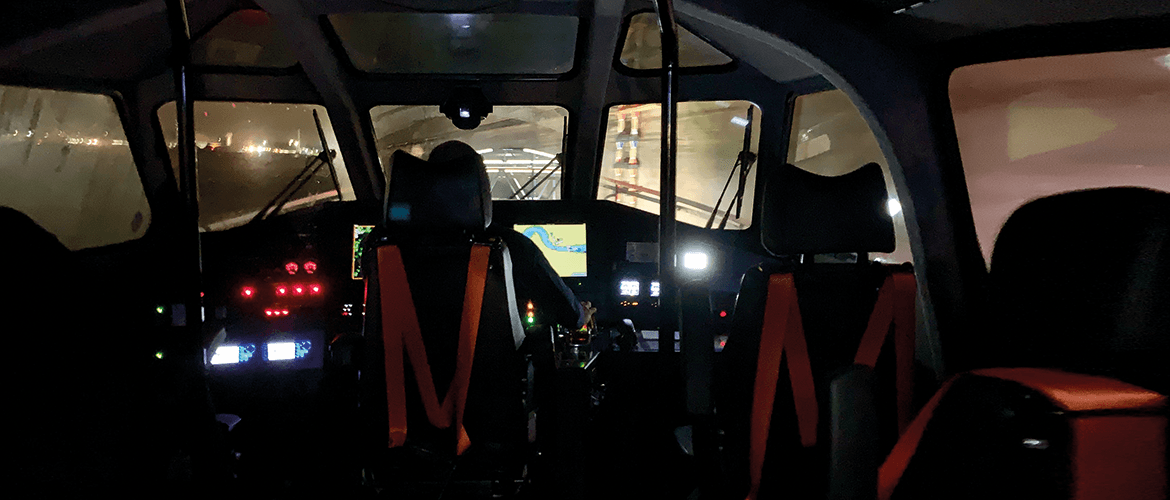
RIVER USE 2020
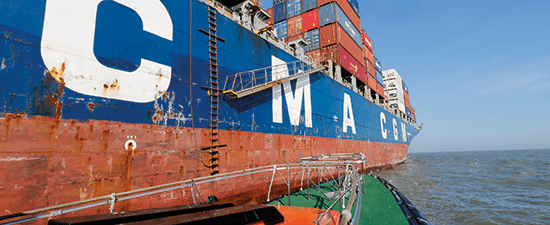
PORT TRADETrade in the Port of London fell to 47.4 million tonnes in 2020, down 12% from 54.0 million tonnes in 2019. The fall in cargo volumes reflected reduced economic activity, following the introduction of COVID-19 restrictions. Unitised trades were most robust, falling by just 1% to 21.8 million tonnes, from 22.1 million tonnes in 2019. This resulted from the continued growth in calls at London Gateway, and the benefits of investment in new, expanded capacity at both Tilbury2 and C-Ro Ports as the Thames emerged as a route well suited to post-Brexit trade. Phase one of Tilbury2 opened in May; the full year benefit is expected to be seen in 2021. Movement of building materials (10.9 million tonnes) remained similarly resilient, down by only 9%; the bulk of this fall linked to the closure of building sites in the first national lockdown in the Spring. The most substantial fall was in oil product trades, down from 13.3 million in 2019 to 8.9 million tonnes in 2020 (-34%), following reduced personal travel and the virtual suspension of air travel in particular. Further detail on port trade is in the Chief Executive’s Statement. 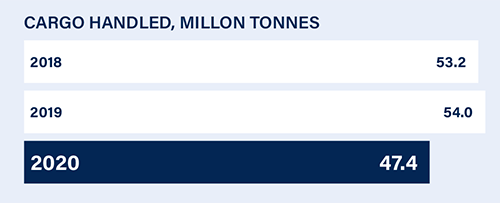 |
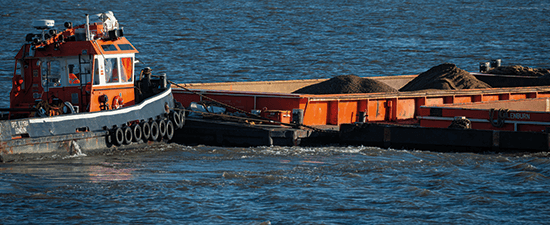
INLAND WATERWAYS FREIGHTFreight moved between terminals on the Thames in 2020 totalled 3.4 million tonnes, down from 4.8 million tonnes in 2019. The overall tonnage of materials moved was affected by pandemic related lockdowns. Cory Riverside Energy continued their essential refuse related operations throughout the year. The Tideway project suspended operations during the first lockdown, but continued operations thereafter, in line with Government guidance. With other construction schemes similarly affected, the barge movement of building materials was severely reduced around March and April. Development of the marine industrial complex encompassing the safeguarded Peruvian and Royal Primrose wharfs continued. Peruvian is occupied and operational with tenants, Brett Group and Keltbray. River wall improvement works will be undertaken at Royal Primrose before it returns to operation. We are in discussion with two operators to take occupation of Royal Primrose Wharf, both of whom will use the river. Pinns Wharf, a safeguarded wharf in Barking Creek came back into operation, initially for the movement of aggregates from the Isle of Grain to the wharf by barge. By the end of the year, joint work by a cross PLA team of planning, harbour masters, pilots and hydrographic, together with site owners, Corbyn, saw the arrival of the first seagoing ship in five years, loading a variety of bulk cargoes for export to the continent. DHL launched the first light freight operation on the Thames as part of its London parcel delivery service. 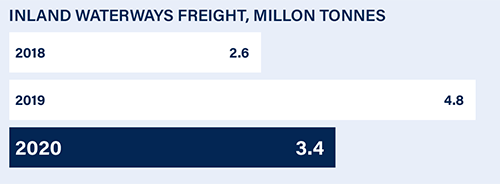 |
|
|
PASSENGER TRAVELThe number of passenger trips on the river fell sharply in 2020 as COVID-19 restricted commuter and tourist travel across the capital. A total of 2.7 million passenger trips were completed, compared to 9.9 million in 2019. A major riverside residential development, Barking Riverside, announced that it was working on plans for the development of passenger services through a partnership with Thames Clippers. They are aiming for their new pier to be open in the winter of 2021. Plans to improve cross river connectivity with an electric ferry crossing between Rotherhithe and Canary Wharf were put on hold due to Transport for London budget constraints. We released the findings of work completed for the PLA and Transport for London by ARUP to identify opportunities for passenger travel growth and potential obstacles to progress. The report will help inform the passenger travel targets in the refreshed Vision that will be developed during 2021. The Gravesend Tilbury ferry continued operating throughout 2020, providing an essential cross river link for communities in Essex and Kent. 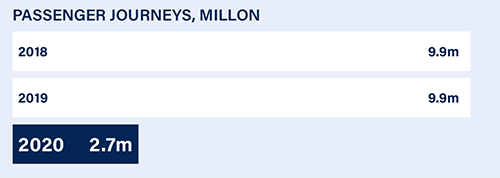 |
SPORT AND RECREATIONCOVID restrictions dramatically affected sport and recreation on the Thames in 2020. The number of river events fell to 168, from the 2019 all-time high of 430. Marquee events to be affected were the University Boat Races and the Great River Race. Some sporting bases continued to play a key role in their communities, with the AHOY Centre providing hot meals for families in need. In light of limited funds and restricted ability to visit sites, our sports participation work focused on formally establishing the partnerships needed to deliver the new Active Thames programme. By the end of the year partnership agreements had been signed with the relevant watersport National Governing Bodies. Support and advice were provided direct to clubs through the pandemic to assist them in their work to access funding needed to ensure their survival. A number of grants were secured as a result. One off PLA grant support was provided to three clubs/organisations. 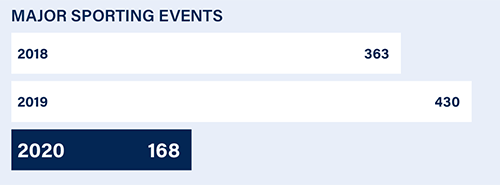 |

RIVER NAVIGATION AND SAFETY
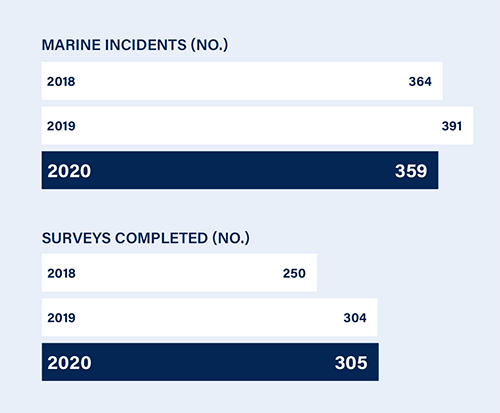
Our main operational responsibility is maintaining the Thames river channels and managing navigation along 95 miles of the tidal Thames, downstream of Teddington Lock. We use our Marine Safety Management System to review the hazards and risks to safe navigation and put measures in place to address them. These include navigation lights and buoys, hydrographic services, pilotage and Vessel Traffic Services control centres at Woolwich and Gravesend, which oversee safe navigation over 400 square miles.
Our latest three-year Marine Safety Plan reached its final year in 2020. The main Plan objective - reducing serious and very serious incidents year-on-year – was achieved with no such incidents in the 12 months (2019: six incidents).
The 2020 safety performance continues the trend of progressively reducing serious incidents on the Thames. While this improvement does draw on our continuing incident analysis and learning lessons from them, the reduced level of activity in some parts of the river inevitably played a part in reducing incidents.
We are now using a new risk management system, Resolver, to support our ongoing work further to improve navigational safety. The software connects risks to incidents, so that we can quantify the impact of risk mitigation plans, identify risk register gaps and conduct actionable risk assessments.
We ran two safety campaigns to support and promote safe navigation on the river. In Maritime Safety Week we called on river users to make reporting ‘Near Misses’ a priority, as learning from a Near Miss can prevent a similar incident, possibly with more serious consequences. This was followed at Christmas with a drive around the ‘Christmas cocktail’ to avoid – a combination of alcohol, drugs and activity on or by the tidal Thames.
Our approach to emergency preparedness evolved, now under the marine compliance manager’s remit. An exercise was carried out in conjunction with the Control of Major Accident Hazards (COMAH) designated site, Navigator in March 2020, where we mobilised tactical and operational teams in response to a simulated oil spill. At the same time, the strategic team were put through their paces when a specialist media team simulated real life media interest in the spill.
The development of a new continuous professional development (CPD) programme with the Company of Watermen and Lightermen and the Thames Skills Academy was also progressed during 2020. This is an important development which will support better safety standards on the Thames, helping people working afloat enhance their skills in line with latest practice.
With COVID prompting greater numbers of mental health crises, we worked with Thames Water Safety Forum members on two Drowning Prevention Strategy initiatives.
Safer Riverside guidance was produced for new developments alongside and on the tidal Thames, giving specific advice on bridges, riverside edges and privately-owned, but publicly accessible, piers and jetties. Separately, the Marine Policing Unit, in collaboration with the NHS, was able to secure a mental health nurse and NHS police liaison officer to be permanently based at Wapping Police Station. They cover all River Thames incidents, from Dartford to Hampton Court and can provide rapid support if needed.
Recreational use of the river through 2020 was far lower than normal, as lockdowns and other restrictions related to COVID-19 prevented people getting afloat. However, a surge in swimmers and people using unsuitable inflatables on the Thames in London emerged in the hotter weeks of lockdown. We issued reminders in response, stressing the need only to go afloat when properly equipped and knowledgeable to do so.
Our options for enforcement and encouraging better navigation on the Thames range from prosecutions to ‘educational advice’, the latter normally delivered from crews on our patrol boats direct to river users. In 2020 there were more than 100 such interventions, almost five times the normal number, an increase linked to the use of unsuitable craft and equipment on which people chose to take to the river.
Our hydrographic team provides essential safety information for river users and their service was uninterrupted through 2020. The team completed 200 km2 of surveys for safety of navigation and conservancy work programmes, exceeding their target by 5%.
A 20% increase on 2019 Electronic Navigation Charts production was achieved and the average time for data to be made available following survey was cut by half, through improved workflows and project management. The hydro team played a key role in supporting major projects on the Thames at Tilbury2, London Gateway and Tideway.
The closure in August 2020 of Hammersmith Bridge to all traffic, including vessels on the river, proved problematic for river users. We are waiting for a long-term solution to address the bridge’s structural safety and in the meantime working with Hammersmith & Fulham Council on the operation of a system allowing river users to book transits at a limited number of times each weekend.

ENVIRONMENTAL STEWARDSHIP
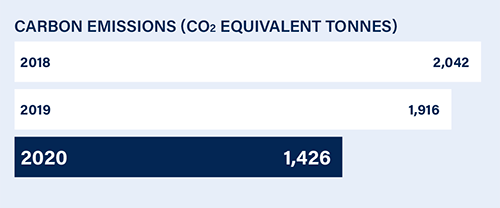
We conserve and enhance a range of diverse, thriving habitats for many different species of fish, birds, seals and other wildlife alongside the commercial port and river activities. Our environment team works across an environmental agenda encompassing air quality, carbon emissions, habitats and water quality.
The major development in the year was our commitment to achieve Net Zero by 2040 and to more than halve emissions by 2025. This was announced in November, following 18 months’ development work by a cross company team; the commitment is based on a comprehensive delivery plan.
The initial main reduction in carbon emissions will be achieved by transitioning our vessels to using biofuel, through a series of investments in fuel tanks and associated equipment. In line with our Net Zero commitment, this year we are making our first formal disclosure of greenhouse gas emissions and energy use, to comply with the Government’s new Streamlined Energy and Carbon Reporting (SECR) requirements (see opposite page). This means we have adopted new ways of presenting data shared previously.
Carbon emitted in 2020 was 1,427 CO2 equivalent tonnes. This is markedly down from the 1,916 CO2 equivalent tonnes emitted in 2019; the decline flows from reduced harbour patrol and other operations, as a result of pandemic lockdowns. The first full year of operations using our hybrid pilot cutter, Leader, also contributed to the decline, along with trialling biofuel in our harbour service launch Kew.
Solar panels installed as part of the refurbishment of our main office base, London River House, contributed noticeably to electricity generation, although the installation was only completed in mid-August 2020.
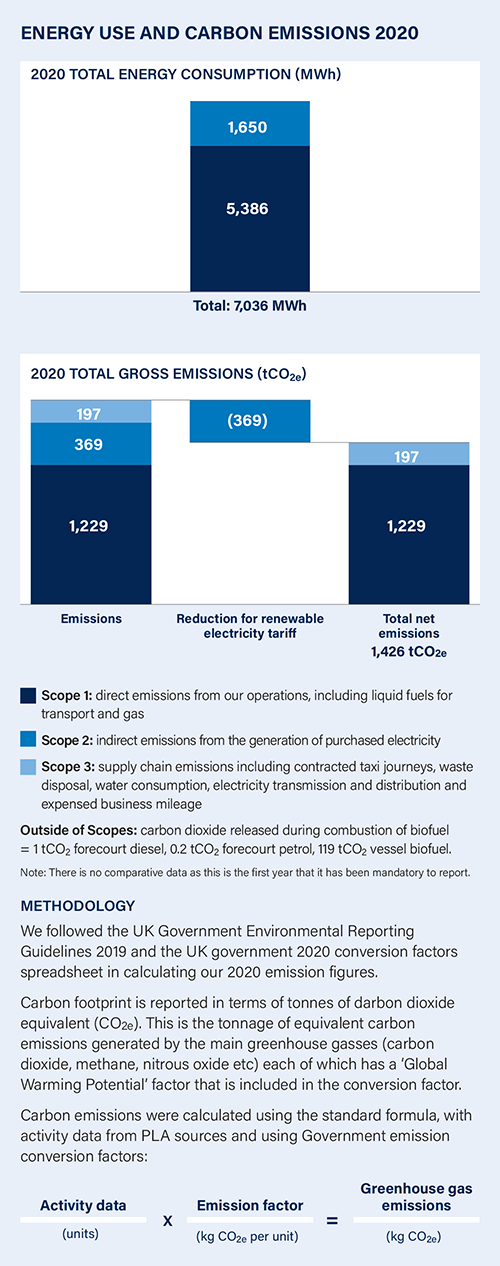
Air Quality remains a major focus. We released the first update of the Air Quality Strategy for the tidal Thames in 2020, reflecting progress made in the two years since the strategy was launched, and capturing new actions responding to rapid changes in technology and regulation. Project work under the Air Quality Strategy continued too as we announced the results of 2019 air quality monitoring around our mid-river mooring at Greenwich.
The first emissions reduction ‘road map’ for a UK port was completed and published, assessing the practicalities for inland vessel operators of employing different propulsion and fuel solutions. This gives operators a resource to draw on in developing their long-term fleet plans.
To help operators further, we ended the year with the launch of Thames Green Scheme, a project encouraging the adoption of more environmentally friendly practices. Through registering and sharing performance data, operators are eligible to display a Green Scheme mark, giving customers information to choose cleaner travel options.
The Green Scheme was launched at our autumn Greening Inland Shipping webinar, convened to provide operators updates on marine propulsion technology developments and adoption.
The ‘green’ discount for environmentally cleaner ships calling on the Thames continued. More than 215 vessels achieving the required Environmental Ships Index standard to qualify for the discount called on the Thames. The benefitting vessels collectively visited the port 979 times.
The Thames Estuary contains significant and protected wetland habitats, supporting a wide range of flora and fauna, including many species that are in decline or under threat. We are currently planning improvements to saltmarsh habitat in West Thurrock, with regulators and adjacent landowners, which we will start delivering in 2021.
In our wider work to support improvements to water quality, we launched a new web resource to help people cleaning up the Thames. The website, Cleaning the Thames, allows people to share details of upcoming clean-ups so people can join in and also share evidence of the improvements the clean-ups made.
NET ZERO TARGET
Our target is to be Net Zero for carbon emissions by 2040. This will be achieved primarily by driving down carbon emissions, with the predicted small amount of remaining emissions removed from the atmosphere by planting on our own estate. The emission reduction will be achieved by a gradual switch to biofuel (until suitable zero emission vessels become available), transition to low and zero emission vehicles and looking to increase on-site generation of renewable energy, while continuing to identify efficiency measures across our operations.
IMPACT OF COVID-19
The Port of London remained operational during the pandemic, but our activities were affected, and vessel fuel consumption dropped by almost one-third. Although essential staff continued to attend site, most office staff worked from home for at least part of the year.
ENERGY EFFICIENCY AND CARBON REDUCTION ACTIONS
In 2020 we completed the refurbishment of London River House, which included replacing the old air conditioning system with new and efficient heating and ventilation, lighting was replaced with low energy LEDs, the roof insulation was improved, low energy and low water consuming appliances were installed. The roof of the main building was replaced with solar photo-voltaic (PV) panels to generate renewable electricity.
Our electricity is supplied on a 100% renewable energy tariff, backed by Renewable Energy Guarantees of Origin (REGOs) and classified as zero emission. The solar PV panels at our Denton Wharf base provide renewable energy for on-site use; new solar PV panels at London River House started generating electricity in August 2020.
During 2020 we completed a successful trial running one of our vessels on biofuel (Hydrogenated Vegetable Oil or HVO, from waste products). Using biofuel significantly reduces Scope 1 emissions as carbon is deemed to be offset by the carbon absorbed during plant growth. HVO will progressively be adopted across our vessel fleet.
CARBON INTENSITY
We have calculated an intensity ratio based on millions of tonnes of cargo handled in the port, as this impacts the intensity of our operations and related energy use. In 2020, 47.4 million tonnes of cargo were handled in the port. This equates to a gross figure of 37.9tCO2e per million tonnes of cargo and a net figure of 30.1 tCO2e per million tonnes of cargo.

PLANNING CONSULTATION & TECHNICAL EXPERTISE
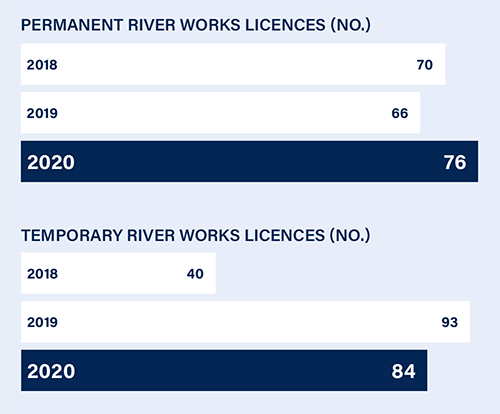
Our planning and technical expertise is at the heart of our work to promote the use of the river. It is widely drawn on as we make sure wharves are maintained and reactivated for port use; provide expert advice to people looking to use the river, whether for trade, travel or leisure; and oversee major events on the Thames.
Demand for our core statutory consenting services through the Port of London Act or through powers within Development Consent Orders (DCO) remained strong, as we reviewed applications for tidal works from major projects including the Thames Tideway Tunnel and Forth Port’s Tilbury 2 scheme. Newer schemes, where demand started to increase as they move closer to major work on site commencing included Silvertown Tunnel and DP World London Gateway’s Berth 4.
The focused processes we developed to handle the high level of consenting needs for the Tideway scheme continued to serve us well, particularly for the Tilbury2 project, where our robust applications process kept pace with their fast-track construction programme and well ahead of the legal requirements as set out in the respective DCOs.
We assessed applications and granted 156 consents for these major projects in the year, compared to 193 in 2019. They continued to represent around half of the licences processed in the year.
We invested in a new licensing portal during 2020 and expect it be fully live this year. The new, streamlined licence applications system makes the process more efficient and allows members of the public to view ongoing applications. It sits alongside a new range of updated river works licence application advice and guidance within our website.
Our support for the development of the Thames Freeport bid was around further developing use of the river for urban logistics and hydrogen infrastructure. Following Government selection of the Freeport, we are working closely with the partners in it, Forth Ports, DP World London Gateway and Ford Dagenham on its detailed development, ahead of formal licensing later in the year.
We continued our discussions with the Illuminated River team and received river works licence applications for the five bridges involved in phase two of the project (Blackfriars Road Bridge, Waterloo Bridge, the Golden Jubilee Footbridges, Westminster Bridge and Lambeth Bridge). The project team is aiming for the lighting to be revealed in Spring 2021.
In April 2020, the Secretary of State for Environment, Food and Rural Affairs approved the remaining sections of the England Coast Path between Grain and Woolwich. This is a project to improve coastal access along a 48-mile stretch of the Kent coast and Thames Estuary that we have been in consultation with Natural England about for some years. We will continue to work with Natural England as they bring the project to fruition.
The UK Ministry of Housing, Communities and Local Government (MHCLG) confirmed the continued protection of strategic sites for port use on the banks of the Thames in London, after an extensive review process conducted by the Greater London Authority, with support from us. The continued protection of the Safeguarded Wharfs is a boost for river use and provides certainty which supports long term investment in river operations.
Early in 2020, Vattenfall’s proposals for extending its Thanet Offshore Wind Farm in Kent were refused by the Secretary of State for Business, Energy and Industrial Strategy on the grounds of significant navigational safety, economic and operational concerns that we presented, working with and on behalf of river operators. This is the first application for a Nationally Significant Infrastructure Project to be rejected.
A long-term project advanced during the year was the submission of our application for a Harbour Revision Order (HRO) to the Marine Management Organisation (MMO). We are seeking an HRO to modernise and increase the transparency of decision-making within relevant sections of the Port of London Act, under which we operate, to reflect modern approaches to consenting, operations and technology in use on the river today.

BRINGING PEOPLE TOGETHER AND PROMOTING THE RIVER
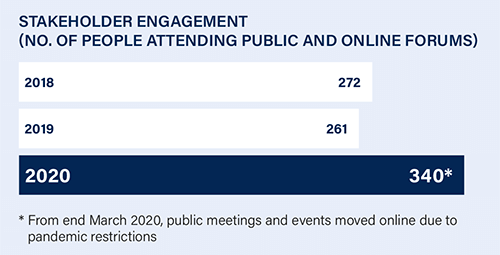
The river is a hub of activity, whether for trade, travel and sports, or a catalyst for investment. At the PLA we are uniquely placed to act as the river’s advocate and convener for those interested in its use and development. This role sees us continually initiating new partnerships, working to develop established ones and showcasing the river in its broadest sense.
We increased the frequency and depth of our communications through 2020 as we responded to, worked with and supported the river community through the COVID-19 pandemic.
From mid-March we produced our e-newsletter, Tidal Thames News on a weekly basis. Initially this was to capture and share the latest guidance and steps being taken to address the pandemic response. It proved invaluable as restrictions changed through the year. More than 50 issues later, it is now established as a valued source bringing together the latest news on river developments.
The Thames Vision is a key part of our work to draw people together and promote the river around a common set of goals. This framework for the development of the river was created in 2015/16 so that the tidal Thames’ full potential was recognised and embraced. Our plans to refresh the Vision in 2020 were put on hold as our and stakeholders’ primary concern was pandemic response.
An updated economic impact report for the port was completed in February, providing a useful pre-COVID benchmark for development plans.
In 2021 our aspiration is to progress the refresh of the Vision, creating a framework which supports recovery and reflects changes in environmental focus as we move towards Net Zero, evolution in river use and logistics. Oxford Economics has been appointed to undertake a trade forecasting study to inform the refresh, which will also draw on the findings in an ARUP report into realising the full potential of the river for passenger transport.
To help shape our thinking for the Vision refresh, we created and hosted the first Great River Cities of the World webinar in autumn 2020. The webinar was based on snapshot research commissioned from the Business of Cities, looking at how the pandemic was shaping river cities' plans for their rivers in the short-, medium- and long-term. It highlighted six common questions that river cities are addressing, which will form the basis for further dialogue later in 2021.
Our partnership with Kate Willard, the Thames Estuary Envoy and the Thames Estuary Growth Board grew strongly through 2020. This saw us contribute to the development of their Action Plan, The Green Blue, which sets out a vision for driving sustainable, economic growth; regenerating infrastructure; and improving transport and connectivity. We are now working together on Action Plan development projects, which align closely with the Thames Vision, particularly river-based urban logistics and the development of the hydrogen ecosystem.
The role of the river in a green recovery is the focus of a reconstituted Thames and London Waterways Forum (TLWF) Steering Group, which brings together PLA with GLA and TfL to deliver on our shared objectives. This includes issues such as safety, air quality, passenger transport sector needs and progressing the development of river logistics with London boroughs. The TLWF annual event was not delivered in 2020, but will be held in 2021 to report on progress.
We have continued to convene partners involved in the development of cultural activities along the Thames through the TLWF People and Places Working Group. As well as co-ordination and facilitation of joint working in central London, such as with Illuminated River, the group is starting to include additional partners reflecting exciting developments in the east, such as Thamesmead.
The Port of London Infrastructure Group continued to meet through 2020, providing the major terminal operators a forum to update on their activities as well as hear from and put issues to politicians, Government officials and those involved in the planning and delivery of major infrastructure projects.

PLA IN THE COMMUNITY
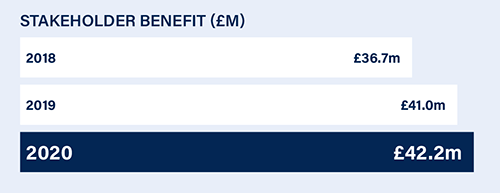
As a Trust Port, we look after the river for the benefit of many stakeholders and, ultimately, future generations. We are active members of the river and wider communities, generating benefits well beyond those of our core operations.
Through payments including wages, taxes, supplies bought in and charitable donations our operations generate substantial stakeholder benefits. We calculate this totalled £42.2 million in 2020 (2019: £41.0 million).
Our support for community projects and partnerships that directly support charitable and stakeholder goals in the year fell to £0.4 million in 2020 (£0.6 million in 2019). This was the result of organisations we support being unable to deliver activities due to COVID-19 lockdowns and concern to limit spend, in line with managing the long-term financial implications of the pandemic.
Given the increased difficulties faced by seafarers as a result of the pandemic, we increased our practical support for them when they were in port. Through the year we provided our long-term partners at Queen Victoria Seaman’s Rest, who run the Tilbury Seafarers’ Centre with essentials such as toiletries and SIM cards for seafarers who were at times confined to their ships in port.
This practical support was reinforced by the Round the World Challenge that our employees took on during the first lockdown. Collectively clocking up 24,000 miles in 13 weeks on foot, by bike and at work on the river, we raised more than £1,200 for the Mission to Seafarers.
The project to repaint the 125-year-old Richmond Lock and Weir was completed in February 2020. This was the conclusion of our largest single community investment (£500,000) of the prior year.
Work started with the Museum of London Docklands, developing plans and content for a six-month exhibition due to open in autumn 2021. The exhibition is set to give people a unique opportunity to explore the history of the Thames and the PLA’s role in its development, stretching back more than 110 years.
Our partners at Thames Festival Trust responded positively to the challenge of COVID, delivering a reimagined Totally Thames river celebration in September. Their programme mixed online and in person riverside events, serving the needs of different audiences.
The Trust’s Thames Lens photographic competition provided people with a prompt to get afloat or riverside, when COVID restrictions allowed in late summer.
The range of education programmes that we support were impacted by the various lockdowns, which generally precluded in-class teaching. The Thames Festival Trust’s Rivers of the World education programme was delivered online to pupils in East London schools. Our links with London Youth Rowing’s Breaking Barriers campaign and Thames Explorer Trust continue and will support delivery of lessons in schools along the river, as soon as circumstances allow.
Participation in sport and recreation on the river was much reduced in the year, in line with Government restrictions. While our Sports Participation Fund grants programme was suspended for the year, we did make one-off grants to help sustain key centres of activity – the AHOY Centre in Deptford and Westminster Boating Base. We also provided one-off support to the Great River Race, to help cover the impact of the 2020 race cancellation.

PLA PEOPLE
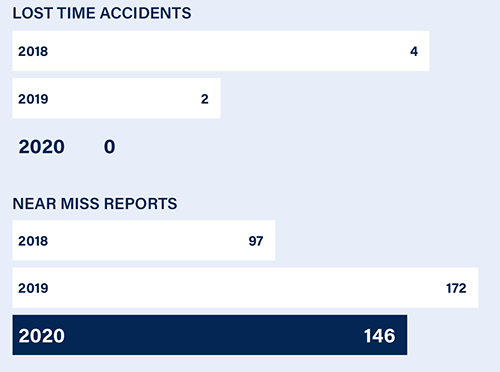
In 2020 in the face of pandemic lockdowns our employees demonstrated the importance of the role they play, day in day out, keeping the UK’s supply chains flowing and millions of people across the south east and beyond supplied with life’s essentials. This was only possible thanks to the team’s blend of seafaring and marine expertise, complemented by specialist electrical and marine engineers, planners, civil engineers, hydrographers, environmental, financial and many other skilled people.
The evolving COVID-19 response was a major focus in 2020. This saw us securing, testing and distributing the personal protective equipment (PPE) needed for operational staff, switching to remote working where appropriate and establishing a COVID-secure workplace.
Throughout, we placed a high priority on staff communications, ensuring that regular updates covered new developments in the company and gave context to national announcements. We adopted and exploited newer communications channels, including Yammer and video briefings to keep teams in touch more effectively.
Throughout, the health, safety and wellbeing of PLA staff was a major priority, particularly as people adjusted to new ways of working. There were no Lost Time Incidents in the year (2019: 2); the total number of incidents was 146 (down from 172 in 2019).
Towards the end of the year we completed the transition of our health & safety management system to the new standard, ISO14500. This change means that all our management systems – quality, environment and health & safety – are now ISO accredited providing a common approach, which seeks continuous improvement, improved risk identification and closer senior leadership involvement.
Our new health, safety and wellbeing team continued to innovate, in line with the plan adopted in late 2019. Developments included an improved new starter, contractor and visitor induction experience and a new interactive film, Turning the Tide, the first element of a behavioural programme and key for front-line supervisors.
We track staff engagement in the business through an annual employee survey. The 2020 score was 79/100, improved from 77/100 in 2019. The survey results reflect the substantial investment we make in being a good employer. This includes active support for training and development, paying the London living wage (including to all contractors) and caring for people’s mental health. In 2020 we promoted Mental Health Day and held a virtual Mental Health month. A special film urging people to take Time to Talk was developed in the latter months of 2020 and released in early February 2021.
In training, we saw four apprentices gain their Boatmasters Certificates, a significant achievement as their time gaining practical experience afloat had been limited due to COVID restrictions. By the end of the year we had taken on three apprentices released early by City Cruises, enabling them to complete their studies and gain the qualifications.
At the end of January 2021, one of our apprentices left the PLA to take up a cadetship that we had brokered with the lighthouse authority, Trinity House. This opportunity will enable her to further develop the marine skills and understanding she developed at the PLA.
Our commitment to fund raising and volunteering continued as far as we were able, given the restrictions faced through the year. Volunteering saw a joint planning, environment and corporate affairs team come together for socially distanced clearing the Denton foreshore of rubbish. The PLA also came together to raise funds for specialised treatment for one of our harbour masters, who is suffering from cancer.
PLA ACTIVITY INDICATORS
As at 31 December 2020
|
Financial Highlights £m |
2020 |
2019 |
2018 |
|
Revenue |
63.8 |
67.4 |
60.9 |
|
Operating surplus |
4.4 |
7.3 |
5.8 |
|
Profit before tax |
2.6 |
10.1 |
4.6 |
|
River Navigation and Safety |
2020 |
2019 |
2018 |
|
Navigational Safety |
|||
|
Marine incidents |
359 |
391 |
364 |
|
Pilotage Service |
|||
|
No. of pilotage acts |
12,715 |
14,238 |
13,372 |
|
No. of pilotage delays |
49 |
224 |
595 |
|
Sea pilot acts service level |
99.50% |
98% |
95.4 |
|
Total no. of pilotage exemption certificates |
130 |
137 |
155 |
|
New pilotage exemption certificates issued |
3 |
17 |
16 |
|
Hydrographic Surveys |
|||
|
Surveys Completed |
305 |
304 |
250 |
|
Area surveyed (km2)* |
200* |
||
|
Diving Operations |
|||
|
Diving operations |
22 |
48 |
61 |
|
Sporting events |
|||
|
No. of sporting events held on river |
168 |
430 |
363 |
|
Environmental Stewardship |
2020 |
2019 |
2018 |
|
Water use (litres) |
|||
|
Rainwater harvesting (Marine House) |
137,000 |
179,000 |
211,000 |
|
PLA carbon footprint (CO2 equivalent tonnes) |
|||
|
Carbon emissions |
1,426 |
1,916 |
2,044 |
|
PLA Energy Use (kilowatt hours) |
|||
|
Electricity consumed |
1,649,588 |
1,427,120 |
1,475,510 |
|
Electricity generated |
67,722 |
50,003 |
48,886 |
|
Gas consumed** |
441,232 |
494,130 |
589,408 |
|
PLA waste generation and recycling (tonnes) |
|||
|
Pre-segregated recyclable |
135 |
77 |
212 |
|
General waste (energy from waste) |
37 |
59 |
114 |
|
Hazardous waste (treatment) |
42 |
96 |
101 |
|
Miscellaneous waste (landfill) |
0 |
0 |
0 |
|
Driftwood recovered (tonnes) |
|||
|
Tonnage of material recovered from the river |
214 |
219 |
144 |
|
Thames Oil Spill Clearance Association (TOSCA) |
|||
|
Call outs |
14 |
18 |
13 |
|
Oil encountered (including sheen) |
8 |
16 |
8 |
|
False alarms (nothing found) |
4 |
2 |
5 |
|
Other call outs (safety of life, etc.,) |
9 |
4 |
7 |
|
Harbour Service only call outs |
1 |
14 |
8 |
|
Convening Stakeholders & River Advocacy |
2020 |
2019 |
2018 |
|
Stakeholder Meetings |
|||
|
No. of public meetings held |
1 |
4 |
3 |
|
No. of people attending public meetings |
65 |
124 |
130 |
|
No of people attending webinars |
281 |
||
|
No. of stakeholder forums |
0*** |
1 |
1 |
|
No. of people attending stakeholder forums |
0*** |
137 |
142 |
*Area surveyed not reported in prior years
**estimated
***Stakeholder engagement switched to online in response to COVID-19 restrictions.
|
PLA People |
2020 |
2019 |
2018 |
|
Personal Health & Safety Statistics |
|||
|
Lost Time Accidents |
0 |
2 |
4 |
|
Near miss reports |
146 |
172 |
97 |
|
Workforce Diversity |
|||
|
% of workforce that are women |
21.39 |
20 |
18.40 |
|
% of workforce who are women in senior positions |
21.28 |
33.30 |
27.00 |
|
% total Black, Minority or Ethnic origin |
1.7* |
2.60 |
2.40 |
|
Customer Feedback |
|||
|
Positive feedback |
26 |
42 |
66 |
|
Complaints |
37 |
10 |
13 |
|
Planning and technical expertise |
2020 |
2019 |
2018 |
|
River Works Licences |
|||
|
Permanent River Works |
76 |
66 |
70 |
|
Temporary River Works |
84 |
93 |
40 |
|
Dredging |
29 |
15 |
24 |
|
Total |
189 |
174 |
134 |
|
Permits |
|||
|
Foreshore permits (including renewals) |
1,363 |
1,000 |
672 |
|
Major Projects |
|||
|
Thames Tideway Tunnel |
|||
|
Discharges (water to river) |
9 |
21 |
9 |
|
Tidal Works |
123 |
142 |
259 |
|
Total |
132 |
163 |
268 |
|
Tilbury2 |
|||
|
Tidal Works |
14 |
23 |
– |
|
London Gateway Berth 4 |
|||
|
Tidal Works |
2 |
1 |
– |
|
Silvertown Tunnel |
|||
|
Tidal Works |
8 |
– |
– |
* the majority of employees do not disclose this information
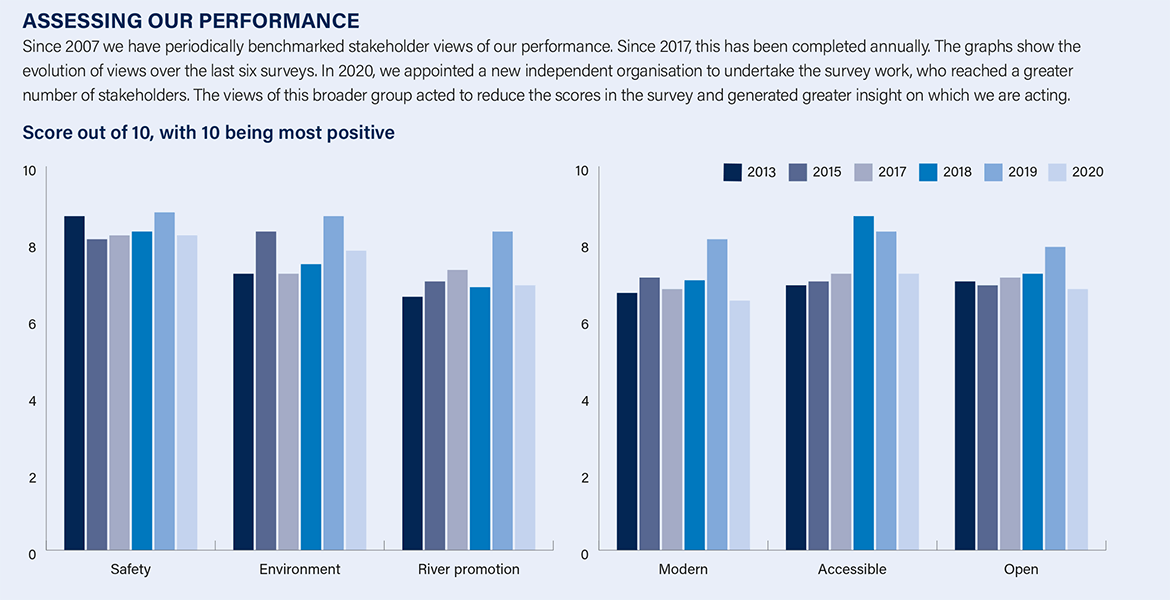
Port trade statistics
As at 31 December 2020
|
Trade (million tonnes) |
2020 |
2019 |
|
Imports |
38.4 |
44.5 |
|
Exports |
9.0 |
9.5 |
|
Total |
47.4 |
54.0 |
|
Unitised traffic |
||
|
2020 |
2019 |
|
|
Imports |
1,344 |
1,321 |
|
Exports |
1,428 |
1,469 |
|
Total |
2,772 |
2,790 |
|
Number of chargeable vessel arrivals to the Port of London |
||
|
2020 |
2019* |
|
|
Total |
9,717 |
11,104 |
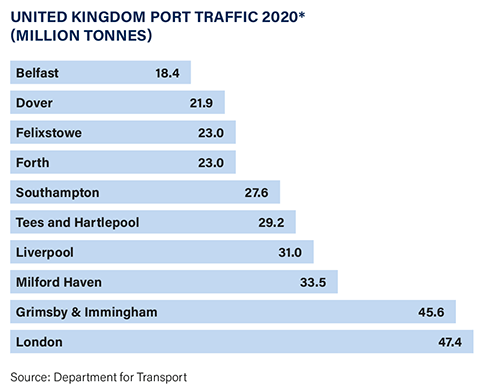 |
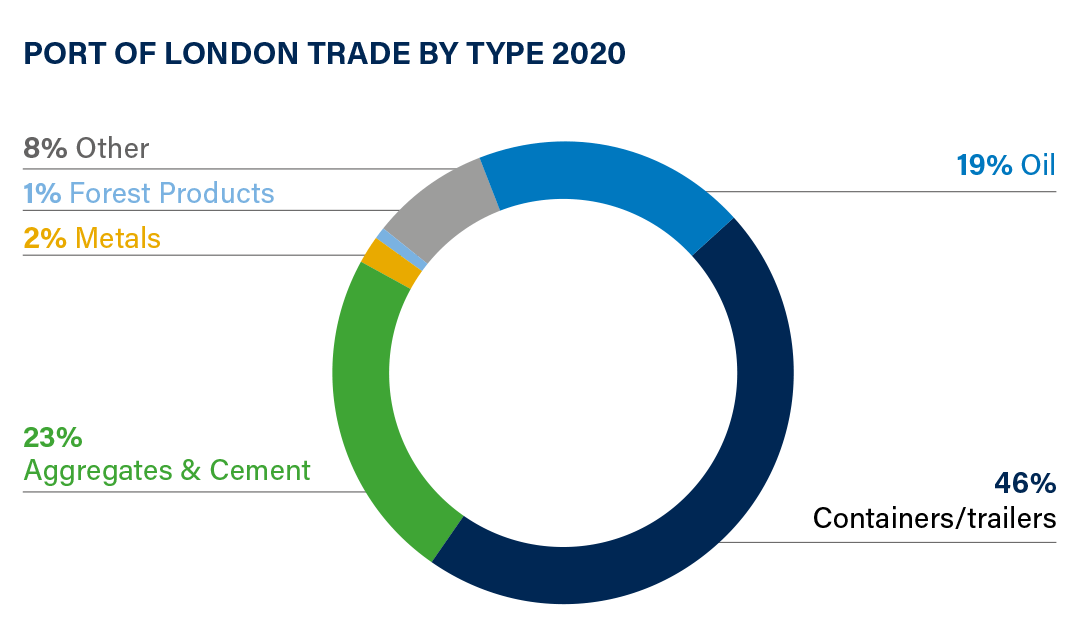 |
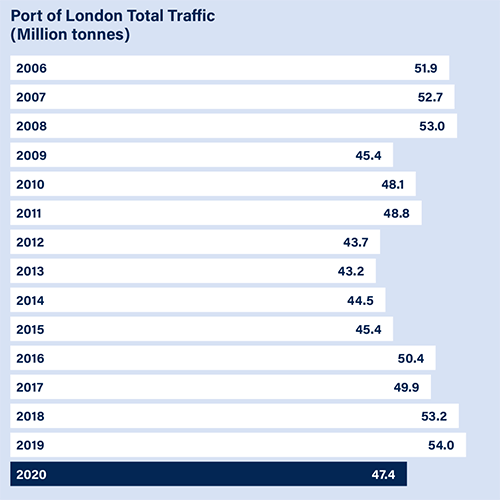 |
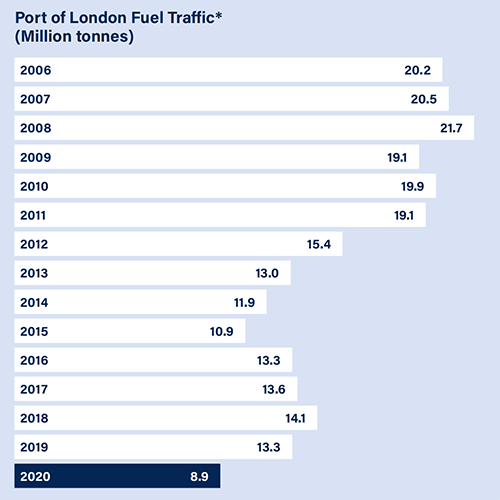 |
Port of London Total Traffic
|
Imports million tonnes |
Exports million tonnes |
Total million tonnes |
||||
|
2020 |
2019 |
2020 |
2019 |
2020 |
2019 |
|
|
Oil, crude & products |
8.7 |
13.3 |
0.2 |
0.0 |
8.9 |
13.3 |
|
Containers & trailers |
14.9 |
14.7 |
6.9 |
7.4 |
21.8 |
22.1 |
|
Aggregates & cement |
10.9 |
12.0 |
0.0 |
0.0 |
10.9 |
12.0 |
|
Other cargo |
2.9 |
3.2 |
1.1 |
1.2 |
4.0 |
4.4 |
|
Forest products |
0.7 |
0.8 |
0.0 |
0.0 |
0.7 |
0.8 |
|
Metals & ores |
0.3 |
0.5 |
0.8 |
0.9 |
1.1 |
1.4 |
|
TOTAL |
38.4 |
44.5 |
9.0 |
9.5 |
47.4 |
54.0 |
The above figures exclude the transport of refuse and other internal port traffic.
Unitised Traffic – (included in above tonnages)
|
Imports |
Exports |
Total |
||||
|
000 20-foot equivalent units |
000 20-foot equivalent units |
000 20-foot equivalent units |
||||
|
2020 |
2019 |
2020 |
2019 |
2020 |
2019 |
|
|
Ro/Ro terminals |
479 |
515 |
471 |
511 |
950 |
1,026 |
|
Container terminals |
865 |
806 |
957 |
958 |
1,822 |
1,764 |
|
Unitised Total (TEUs) |
1,344 |
1,321 |
1,428 |
1,469 |
2,772 |
2,790 |
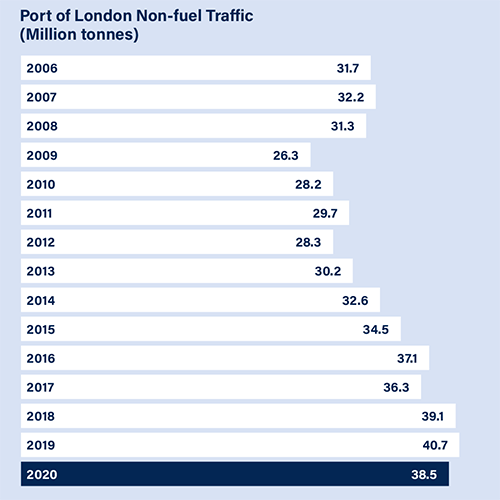 |
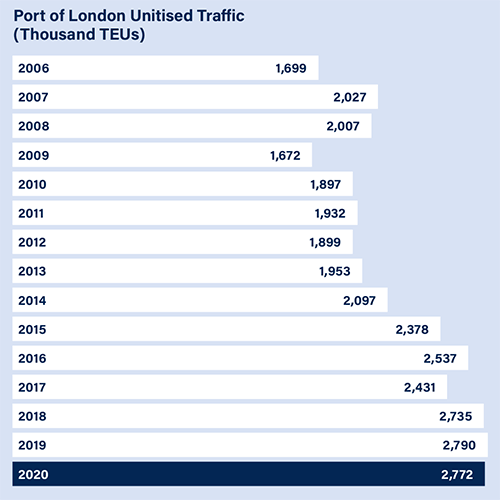 |
REVIEW OF PRINCIPAL RISKS
This statement captures the collective view of the Board and Executive Committee of the principal risks that the PLA works to manage. The key risks have a broad spread across safety, operational, economic aspects, coronavirus measures, cyber security and climate change. Reputational risk is not given a separate listing; it is inherent in failing adequately to deal with the key risks identified here.
CORONAVIRUS
The outbreak of the coronavirus, and the unprecedented steps being taken around the world in response, is a significant risk for the PLA. The potential impact runs across the business, from personal health & safety to operational resilience, and, as economic activity continues to be subject to both national and international restrictions, the viability of some of our customers and the long-term health of our finances.
Mitigating steps include continuing the practice of social distancing and working within cohorts where possible to help prevent the spread of the disease, curtailing and delaying non-essential expenditure and continued close customer liaison as part of horizon scanning. We have looked at the financial resilience of our business and have put in place measures to monitor and mitigate the risks as they are developing.
SAFETY
Numerous mitigating systems are in place on the river, including an effective navigational Safety Management System (SMS), risk assessment/hazard reviews, Vessel Traffic Services (VTS), pilotage, hydrography, Passenger Boat Code of Practice, Automatic Identification System (AIS), RNLI and London Coastguard, special signal lights and speed control byelaws.
The PLA also hosts safety orientated initiatives such as seminars and works closely with security services. In the context of growing volumes of river traffic, the continued trading of historic passenger boats, with the risk of significant loss of loss of life if one of these vessels was involved in a collision and foundered, is an ongoing concern. We strongly endorsed the Maritime & Coastguard Agency consultation and support proposals to amend the technical requirements for older Domestic Passenger Vessels to be more comparable with modern regulations.
Personal Health & Safety is a priority in the business, managed through personal responsibility, our Golden Rules – Care, Challenge and Comply – and our safety management system.
OPERATIONAL
The most significant operational risk to the PLA would be the closure or partial closure of the port, significantly disrupting or halting operations and trade. There are a number of possible causes including, but not limited, to:
- collision;
- grounding;
- foundering;
- bridge or barrier closure;
- deliberate terrorist / pressure group action; and
- significant cyber security incident.
Mitigations include effective navigational SMS, risk assessment/hazard review, VTS, pilotage, and hydrography. The PLA undertakes frequent in-depth emergency exercises and has historically worked closely with both the Maritime & Coastguard Agency and Secretary of State’s Representative (SOSREP) which would be key factors to clearing navigational channels as quickly and efficiently as possible. We also participate in the Thames Security Forum and resilience groups.
Where the river is closed to navigation for an extended period, for example through the closure of Hammersmith Bridge, we engage actively with all parties to support the delivery of interim and long-term solutions.
ECONOMIC
A fundamental shift in the micro or macro financial environment in which the PLA operates has the greatest potential to impact the Port of London in general and the PLA’s finances in particular. This includes anything from a global pandemic as we have experienced in 2020, as well as changes in trade such as business cessation of a major customer or change in the consumer market which impacts both the type and volume of cargo demanded, through to national or international economic factors such as a change in global trading patterns, or changes resulting from Brexit.
The organisation is sufficiently agile to react to changes and our communication channels help to anticipate any such change in sufficient time to react accordingly by making a corresponding shift in our cost base. Debt management protocols are in place and international exposure is minimised as far as is possible. Five-year business plans as well as an annual forecast and budget exercise are undertaken.
FINANCIAL
Post 2019, the coronavirus has presented a challenge to all businesses; this has tested both our resilience and our agility to react quickly. We have prepared detailed sensitivity analysis and financial scenarios looking at the potential impact on our cashflow, extending out to the next 12 months, as well as the preparation of a ten-year business plan to assess the long-term use of available resources.
We have assessed the economic impact on our customers and their ongoing trading position as part of our bad debt review process. As a mitigation, we assessed, but did not access, the Government business interruption financial assistance packages and job retention schemes and we do have sufficient assets we can borrow against, if needed.
Following the latest triennial valuation there continues to be a substantial deficit on an actuarial basis on the PLA Pension Fund of £61.1 million. Coronavirus has increased this deficit and in 2021 we will have a new valuation. In January 2021 we launched a new Defined Contribution scheme, which will replace the Defined Benefit scheme for new employees.
The Pilots National Pension Fund, a multi-employer scheme, also has a substantial deficit in which the PLA has a share in the region of 6.7%. It is a long-term open-ended industry-wide liability over which individual employers have little influence. An industry-wide repair plan is in place which, in common with many ports, is funded by way of a levy on pilotage charges.
SIGNIFICANT CYBER SECURITY INCIDENT
All businesses face the possibility of a successful cyber security breach. Threats can vary in their complexity and sophistication and can potentially negatively impact organisations of all sizes. We deploy a range of industry-standard security products, both internally and on our network perimeters.
Formal security and IT conditions of use policies are established, which define security standards and acceptable use. Office-based staff receive security awareness training and guidance on detecting ‘phishing’ and other malicious emails and we continue to enhance data governance processes including formalised data retention and classification policies. In 2020 we further increased our security measures as a response to a phishing incident.
CLIMATE CHANGE
Climate change is a subject with which we have been engaged for a number of years, but it is now viewed as one of the principal risks to which the PLA and stakeholders have to respond. As a port handling more than 10 million tonnes of cargo, we completed a risk assessment and submitted our first Climate Change Adaptation Report to Defra under the Climate Change Act in 2011. The risk assessment was updated, and a second Adaptation Report submitted in 2015. It has been updated again – in the light of subsequent experience – for the third report, supported by intermediate risk assessment and updates from predictions. It was submitted at the end of 2020, in accordance with the timetable agreed with Defra.
In responding to climate change, in 2019 the UK Government made a legally binding commitment to achieving a Net Zero Carbon economy by 2050. This will result in wholesale change across the economy and the ports that serve it. For the Port of London major changes that are likely, or potentially likely, to result include: the long-term reduction in tonnages of oil related cargoes (currently representing around a quarter of port trade and a major source of income); development of new “green” cargoes; existing vessels’ propulsion systems becoming obsolete; need to adopt new technologies; dealing with unforeseen legislative changes; and managing the impact of extreme weather.
In managing this risk, the PLA has established a major project and subsequently developed plans for a Net Zero PLA and continues to support decarbonisation in the wider port, in line with the focus of the Thames Vision refresh.
LONG-TERM VIABILITY STATEMENT
The Board has assessed the viability of the company over a five-year period to December 2025, taking account of the company’s current position and potential impact of the principal risks documented in the corporate risk register. The five-year review period was selected for the following reasons:
I. A five-year financial plan is presented to the Board for approval on an annual basis. To go beyond that in a business environment prone to change has in the past proved unrealistic. The recent rapid growth in vessel size is indicative of this.
II. With a balance sheet dominated by pension liabilities it makes sense for us to use a review window which does not extend far beyond the triennial valuation process of the PLA Pension Fund and PNPF.
The Board was presented with a long-term view of the business and in the near term, assessed the level of business disruption and the sensitivity of trading numbers by preparing a cashflow analysis over the period to 31 December 2022 for scenarios of 10%, 15% and 20% reductions in income.
Based on the results of this analysis, the Board has a reasonable expectation that the company will be able to continue in operation and meet its liabilities as they fall due over the period to December 2025.
In making this statement the Board has considered the resilience of the company, taking account of its current position, the principal risks facing the business in severe but realistic scenarios and the effectiveness of any mitigating actions. This assessment has considered the potential impacts of these risks on the business model, future performance, solvency and liquidity over the period.
GOVERNANCE
CORPORATE GOVERNANCE REPORT
OUR YEAR
During 2020, the Board focussed the organisation on the following priority areas: coronavirus support, staff, health and safety, pricing, environment, investment, Harbour Revision Order (HRO), pensions and significant risk.
The Board met 12 times in total. Due to coronavirus restrictions the majority of these took place via video conference:
- six Board meetings (four via video conference)
- one virtual away day
- one video conference to discuss the 2020 budget and pension options
- four special Board updates (via video conference) to discuss the PLA’s response to coronavirus
The substantive items we addressed together at the Board included:
- Coronavirus response
- Contingency plan
- Green PLA and Green Port
- New Defined Contribution (DC) scheme
- Capital Allocation framework
- Thames Europort site, Dartford
- Hammersmith Bridge
- Five-year business plan
- 2021 objectives
- Brexit
OUR APPROACH
The PLA Board is the duty holder on health and safety and the accountable body for navigational safety under the Port Marine Safety Code (PMSC). Performance is reviewed regularly, with the guidance of our independent designated person, in order to ensure compliance.
The Board’s role is to set the strategy for the PLA, ensure its long-term success and create stakeholder value. In particular we have a duty to manage the tidal river Thames in trust for future generations and to pass it on to our successors in an improved condition. As a provider of essential navigational safety services, we have to ensure that the organisation is efficient and provides customers with cost-effective services. With no shareholders, we are accountable to stakeholders and value their input in shaping the approach and decisions that we take.
We are committed to maintaining the highest standards of corporate governance and follow the Ports Good Governance Guidance and the UK Corporate Governance Code (where appropriate for a statutory organisation).
As the Board, we regularly receive detailed financial and operational information to allow us to monitor the key areas of the business. Senior managers regularly brief us on various aspects of the PLA’s work.
OUR GOVERNANCE STRUCTURE
Seven scheduled Board meetings (including one virtual away day) were held during the year. In addition, the six committees of the Board overseeing specific elements of the business met and reported back, as needed. The committees are:
A Audit Committee
L Licensing Committee
N Nominations Committee
R Remuneration Committee
P Pensions Advisory Committee
I Investment Committee
T Thames Vision Committee
Jump to a series of short reports on each of the committees.
OUR PEOPLE
The Board is made up of a chair together with seven non-executive and three executive members.
OUR STAKEHOLDERS
Open communication with our stakeholder community is at the heart of our operations. Consistent with Ports Good Governance Guidance, we hold an Annual Stakeholders’ Forum, where stakeholders have an opportunity to meet, hear from and challenge the Executive and Board. A number of open Public Meetings and River User Consultative Forums are held, giving stakeholders further opportunity for dialogue with the PLA. In 2020, we switched to online engagement in order to maintain dialogue while complying with COVID-19 restrictions. See our Section 172(1) statement on page 22 for more information.
OUR APPROACH TO RISK
We adopt a prudent approach to the management of risk in the business. This is consistent with our prime role, providing an essential safety service to our customers. We are also a commercial organisation and accept some level of risk as a normal consequence of doing business. More details of our approach to risk identification and management can be found on page 42.
BOARD EFFECTIVENESS REVIEW
During December 2020, an internal Board evaluation was undertaken as part of the Board’s review cycle.
We welcome any feedback you may have on this Annual Report – please use this form to send your comments.
Christopher Rodrigues CBE
Chairman
9 April 2021
BOARD MEMBERS
As at 30 March 2021
|
NON-EXECUTIVE MEMBERS |
|||
|
|
|
|
|
|
Christopher Rodrigues CBE (DfT) |
Alun Griffiths |
Judith Armitt |
Paula Carter |
|
Chairman |
Vice Chairman |
Non-Executive Director |
Non-Executive Director |
|
Qualifications: MA Cambridge, |
Qualifications: BSc(Hons) Applied Economics |
Qualifications: MA Philosophy, Politics and Economics, Chartered Institute of Public Finance and Accountancy (CCAB qualified) |
Qualifications: MA Oxon, JP |
|
Appointed: January 2016 |
Appointed: September 2014 |
Appointed: December 2016 |
Appointed: June 2018 |
|
Committee membership: |
Committee membership: |
Committee membership: |
Committee membership: |
|
Christopher Rodrigues became chair of the Port of London Authority in January 2016 and chair of the Royal Ballet School in January 2020. In May 2018 he became an Ambassador for the World Travel and Tourism Council (WTTC), and in January 2019 a council member and chair of the Development Committee at University College School, Hampstead. Christopher was chair of Openwork from January 2014 - June 2020; chair of the British Council from 2016 – 2019; chair of the British Bobsleigh and Skeleton Association from 2013 – 2019; chair of VisitBritain from 2007 – 2017; chair of International Personal Finance and Windsor Leadership from 2007 – 2015; chair of The Almeida Theatre from 2008 – 2016. Christopher was a Council member of the National Trust from 1997 – 2004, and again from 2010 – 2012, and a Trustee from 2012 – 2016. He was on the executive committee of World Travel & Tourism Council from 2007 – 2016. Christopher is a graduate of Cambridge University (MA) and the Harvard Business School (MBA, Baker Scholar). He was awarded an Honorary Degree of Doctor of the University of Surrey (DUniv) in April 2013. He rowed for Cambridge in the 1970 and 1971 Boat Races, is a past-chair of Leander Club and is a steward of Henley Royal Regatta. Christopher was made a Commander of the British Empire in the 2007 New Year Honours list for services to British business interests and charitable works in the UK and USA. |
Alun Griffiths joined the PLA on 1 September 2014 having worked in a number of senior roles in the engineering design, project management and management consultancy industry. His last executive role was as a board member at WS Atkins plc where he was also group HR director. Since retiring from Atkins, he has continued to work at board level in the infrastructure sector at Severfield plc where he is senior independent director and at Ramboll, the international engineering design and architecture business where he is a board member. He also sits on the board at the Anchor Hanover Group. Alun has worked extensively across the science and engineering sectors to improve gender diversity at all levels up to and including the boardroom. |
Judith was appointed a non-executive member of the PLA Board on 1 December 2016. She retired as chief executive of Local Partnerships LLP in April 2016. Prior to this she worked in the Cabinet Office, was managing director of Ashford’s Future Company, Thames Gateway chief executive and chief executive of Medway Council. Judith is a trustee of the Centre for Engineering and Manufacturing Excellence (CEME), Design: South East, deputy pro-chancellor of Canterbury Christ Church University and chairs their Finance and Resources Committee. |
Paula Carter joined the PLA as a non-executive director on 1 June 2018. She worked for 30 years in broadcasting, most recently as director of planning and board secretary at Channel 4 where she was responsible for all corporate planning. Before joining Channel 4 in 2007 she held senior policy and management roles at the BBC and ITV and worked as an advisor to various government departments, regulators and agencies on communications matters, including the joint Parliamentary committee that scrutinised the Communications Bill in 2002. Before joining the BBC in 1989 she worked in advertising in the UK and New Zealand. Paula is an elected member of the Wine Society, a non-executive director of the productivity movement “Be the Business”, a magistrate on the South East London Bench, chair of Ofcom’s Advisory Committee for England and a Council Member of the RFU. She sits on the Disciplinary Panel for the Lawn Tennis Association. |
|
NON-EXECUTIVE MEMBERS |
|||
|
|
|
|
|
|
Toril Eidesvik |
Darren James |
Sue Mackenzie |
Ian Moncrieff CBE DL |
|
Non-Executive Director |
Non-Executive Director |
Non-Executive Director |
Non-Executive Director |
|
Qualifications: MA Law |
Qualifications: B Eng(Hons) Civil Engineering; C Eng Chartered Engineer, Member of the Engineering Council, Fellow of the Institution of Civil Engineers, Fellow of the Chartered Institution of Highways and Transportation, Fellow of the Institute of Directors |
Qualifications: BSc (Hons) Agricultural Science (Animal), MSc Emergency Planning Management |
Qualifications: BA(Hons) Geography/Geology, IoD Certificate in Company Direction |
|
Appointed: September 2020 |
Appointed: December 2016 |
Appointed: January 2021 |
Appointed: January 2015 |
|
Committee membership: |
Committee membership: |
Committee membership: |
Committee membership: |
|
Toril was appointed as a non-executive member of the PLA Board on 1 September 2020. Toril has worked within the shipping industry in various positions since 2006 where she was elected executive chair of the reefer shipping company Green Reefers. She later served as CEO from 2008 to 2012. Toril served as CEO for the general ship supply company Seven Seas and more recently for the cargo handling equipment supplier TTS Group (now Nekkar). Toril has extensive board experience from several shipping related companies, she spent 15 years as board member for Solstad and is presently a board member of Eksportfinans. She holds a Master of Law from the University of Oslo, worked as a lawyer for the first nine years of her career, firstly within a private law firm and later within the legal department of a bank. |
Darren James joined the PLA Board in December 2016. A chartered civil engineer, Darren graduated with honours from the University of Surrey in 1990. He was appointed chief executive officer at Keltbray in early 2020, having spent the majority of his career at Costain. He came through the graduate programme at Costain as a civil engineer, then through project management on some of the UK’s largest infrastructure programmes to become managing director of their Infrastructure Division. Darren sits on the Prince’s Trust Leadership Group, championing the entry of young people into the industry and is a director of the Rail Industry Association. |
Sue was appointed as a non-executive member of the PLA Board on 1 January 2021 Sue brings a wealth of international, commercial shipping operational experience, having served in senior management and advisory roles for both public and private companies for more than 20 years. She held a variety of roles during nearly 13 years at P&O Ferries most recently as operations and business transformation director. Prior to that she was operations director of London Luton Airport at a time of unprecedented growth following the launch of easyJet. Sue’s early career was spent in military service and not-for-profit sectors both within and outside the UK. After leaving the Army Sue spent time as chief executive of the charity Cities in Schools (CiS), which ran partnership programmes between business and the community to provide education, training and support to disadvantaged young people. Sue currently serves as a non-executive director of BMT Group Ltd and Medway NHS Foundation Trust and is also on the Board of the Logistics UK. Sue continues to work voluntarily in support of her fellow servicemen and women and is involved as a trustee and / or volunteer of several charities in the UK. |
Ian joined the PLA Board as non-executive director and marine member on 1 January 2015. He was formerly chief executive of the UK Hydrographic Office (UKHO) from 2011 - 2015, having been with the UKHO in a variety of roles, including UK national hydrographer as a Rear Admiral since 2006. He served with the Royal Navy for 35 years, accumulating over 20 years’ seagoing experience in 11 warships. His senior roles included Commander British Forces South Atlantic and he commanded the ice-breaker HMS Endurance and destroyer HMS Nottingham and was executive officer of the aircraft carrier, HMS Invincible. Ian is on the NERC Operational and Safety advice Panel for the British Antarctic Survey, deputy lieutenant for the county of Somerset, a trustee of the Falklands Conservation charity and a Governor of Taunton School. He is also a Younger Brother of Trinity House, Master Mariner and member of the Naval & Military and Antarctic Clubs. |
|
EXECUTIVE MEMBERS |
|||
|
|
|
|
|
|
Robin Mortimer |
Julie Tankard |
Robert Baker |
|
|
Chief Executive |
Chief Financial Officer |
Chief Harbour Master |
|
|
Qualifications: BA(Hons), Modern History, Oxford MA; MSc, Development Studies, School of Oriental and African Studies |
Qualifications: FCMA (Fellow Chartered Institute of Management Accountants), GCMA (Global Chartered Management Accountant) |
Qualifications: MBA and Master Mariner |
|
|
Appointed: March 2014 |
Appointed: October 2017 |
Appointed: May 2016 |
|
|
Committee membership: |
Committee membership: |
Committee membership: |
|
|
Robin joined the PLA as chief executive officer on 31 March 2014. Prior to joining the PLA, Robin had 20 years’ experience in the UK Government civil service across a range of Government Departments. He was private secretary to the Environment Secretary from 1996-97, Deputy Prime Minister from 1997-98 and to the Transport Secretary from 2001-03. He led the work on the UK Climate Change Bill in 2006 and in 2007, became a Director in Defra where he set up the UK’s Adapting to Climate Change programme, oversaw the creation of the Canal & River Trust and directed policy on air quality and the natural environment. Robin is currently the vice chair of Maritime UK, a Member of the CBI’s London Council, a trustee of Thames 21 and chair of Estuary Services Ltd, a joint venture subsidiary with Peel Ports. |
Julie Tankard, chief financial officer was appointed in October 2017. Julie is a Fellow of the Chartered Institute of Management Accountants and has over 25 years of experience in finance, primarily in IT and telecommunications. Prior to joining the PLA, Julie was a vice president at BT plc and her last role was responsible for group contract & commercial management. Prior to joining BT, Julie was the finance director for Racal Datacom and prior to that was finance director for the networking division of Unisys UK & EMEA. Julie has also been a non-executive director of a mental health trust in Leeds and York. |
Bob Baker became PLA chief harbour master in May 2016. He is responsible for all operational and navigational matters including vessel traffic management, pilotage, harbour services and port security. Bob joined the PLA from Forth Ports, where he was chief harbour master and a director of Forth Estuary Towage from 2001. Bob’s seagoing career lasted from 1975 to 1991, before he came ashore to work at the Port of Tilbury, latterly as general manager, conventional operations and harbour master. Bob chairs the UKMPG/BPA Marine Pilot Working Group, sits on the Department for Transport’s steering group for the Port Marine Safety Code, is the UK’s representative on the Marine Affairs Committee of the European Sea Ports organisation (ESPO) and is a past president of the UK Harbour Masters Association. He holds an MBA from Henley Management College. |
|
MANAGEMENT EXECUTIVE COMMITTEE
Chief Executive
Robin Mortimer
Chief Financial Officer
Julie Tankard
Chief Harbour Master
Robert Baker
Director of Corporate Affairs & Strategy
Alistair Gale
Director of Marine Operations
Peter Steen
Director of Planning and Environment
James Trimmer
Director of Human Resources
Glenn Witham
SUMMARY STATISTICS
As at 30 March 2021
The Board is made up of a chair together with seven non-executive and three executive members.
There were 11 members of the PLA Board as at 31 March 2021.
Due to the COVID-19 pandemic, the majority of meetings were held via video conference. Two face to face meetings took place.
Attendance at the seven meetings of the PLA Board in 2020 (including away day) was as follows:
CHRISTOPHER RODRIGUES CBE 7
ROBIN MORTIMER 7
JULIE TANKARD 7
ROBERT BAKER 7
ALUN GRIFFITHS 6
ANNETTE MALM JUSTAD 3
(term expired on 31 May 2020)
IAN MONCRIEFF CBE DL 7
HELEN DEEBLE CBE 7
(term expired on 31 December 2020)
DARREN JAMES 7
JUDITH ARMITT 7
PAULA CARTER 7
TORIL EIDESVIK 3
(joined the PLA on 1 September 2020)
The following committees of the Board also met during 2020:
Audit 3
Nominations 2
Licensing 4
Pensions Advisory Committee 1
Remuneration 3
Investment 4
Thames Vision 3
Committee memberships are listed in the Board members’ biographies and in the following short reports on each committee.
COMMITTEES
As at 30 March 2021
BOARD EFFECTIVENESS REVIEW
An internal Board evaluation was undertaken during December 2020. The results and subsequent recommendations were discussed at the February 2021 Board meeting.
AUDIT COMMITTEE | A
Met three times
Current Membership
Judith Armitt (chair), Paula Carter, Sue Mackenzie
Commentary
The audit committee’s role is to:
- advise on the appointment/re-appointment/removal of auditors, their terms of engagement and their level of remuneration
- review the scope and the results of the annual audit and report to the Board on the effectiveness of the audit process
- review and recommend the annual report and accounts to the Board
- monitor the internal and external audit programme and consider the conclusions of audits undertaken
- review the effectiveness of the risk management system
- review the arrangements by which staff may, in confidence, raise concerns about possible improprieties in matters of financial reporting and other matters
- consider the bribery statement and policy as appropriate
- review the slavery and human trafficking statement and policy annually
The principal items discussed during the year were around:
- annual report and accounts
- Ernst & Young’s audit report and audit planning
- slavery and human trafficking policy and statement
- Willis Towers Watson actuarial review
- payroll and HR audit
- bad debts
- risk process
- investment appraisal
- pensions
- GDPR
- tax
- whistleblowing
- legal matters
- revaluation approach
- management systems audit
LICENSING COMMITTEE | L
Met four times
Current Membership
Alun Griffiths (chair), Robin Mortimer, Robert Baker, Ian Moncrieff, Darren James
Commentary
The licensing committee’s role is to:
- approve the processes for administration of the licensing of works
- determine any application considered contentious or significant
- determine any proposal to suspend or revoke a licence, take enforcement action or impose a condition contentious or significant
- approve the granting and appropriate terms, excluding financial, of any leases of PLA land
- approve the use of powers under the Town & Country Planning (General Permitted Development) Order
The principal items discussed during the year included:
- enforcement
- various licence applications
- Thames Tideway Tunnel and Tilbury2 consenting works
- New licensing portal
- Hammersmith Bridge
NOMINATIONS COMMITTEE | N
Met twice
Current Membership
Christopher Rodrigues (chair), Alun Griffiths, additional non-executive director, if required
Commentary
The nominations committee’s role is to:
- recommend to the Board the appointment and reappointment of non-executive directors considering the need for diversity
- advise on the expertise required when a vacancy arises
- recommend to the Board the appointment of a deputy chair
The principal items discussed during 2020 were:
- the appointment of two new non-executive directors
- committee membership
- term extensions
- chair recruitment
RENUMERATION COMMITTEE | R
Met four times
Current Membership
Alun Griffiths (Chair), Christopher Rodrigues, Toril Eidesvik
Commentary
The remuneration committee’s role is to:
- consider and recommend to the Board the remuneration terms for the organisation, including executive and non-executive directors
- succession planning of directors and the senior management team
- oversight of staff development, talent management and organisation culture
The principal items discussed during the year were around:
- review of senior grades
- rewards
- inclusion and diversity
- pay
- collective agreements
- employee relations
PENSIONS ADVISORY COMMITTEE | P
Met once
Current Membership
Christopher Rodrigues (chair), Darren James, Judith Armitt,
Robin Mortimer, Toril Eidesvik
Commentary
The pensions advisory committee’s role is to:
- advise the Board on the overall pension strategy
- maintain a good dialogue with pension fund trustees
- be proactive / reactive regarding investment decisions and strategy
- consider the PLA’s financial prospects and risk appetite
The principal items discussed during the year were:
- PLA pension fund actuarial valuation
- contingency plan / employer action plan
- replacement of PLA Pensions Committee chair
INVESTMENT COMMITTEE | I
Met four times
Current Membership
Darren James (chair), Judith Armitt, Robin Mortimer
Commentary
The investment committee’s role is to:
- review investment proposals and make recommendations to the Board
- carry out post implementation reviews
The principal items discussed during 2020 were:
- investment proposals
- future opportunities
- current investments
- Sustainable Innovation Fund
- GIS-based investment opportunity heat map
THAMES VISION COMMITTEE | T
Met three times
Current Membership
Paula Carter (chair), Christopher Rodrigues, Judith Armitt, Robin Mortimer
Commentary
The Thames Vision committee’s role is to:
- review the strategic approach for delivering and measuring progress on the Thames Vision
- consider priority actions to deliver the Thames Vision linking to the PLA’s business plan
- review progress and action on Vision goals
The principal items discussed during the year included:
- passenger transport<
- priority actions
- approach in light of COVID-19
- action plan
- Economic Impact Study
- Thames Vision refresh
FINANCIAL STATEMENTS
Financial data for the year ended 31 December 2020 are available in PDF format here.
Contents
Overview | Strategic Report | Performance | Governance | Financial Statements


